In 2019, Daniele Bigi had explained ILM‘s work on Aladdin. He then worked on Star Wars: The Rise of Skywalker.
Peter Kyme started his career in visual effects in 2004 at DNEG. He then joined ILM in 2014. He has worked on films like 10,000 BC, Man of Steel and Star Wars: The Last Jedi.
Mathieu Vig started working in visual effects in 2004 at Framestore. He then joined ILM in 2014. He has worked on films such as Gravity, Paddington, Star Wars: The Force Awakens and Ready Player One.
Claudia Lecaros started her career in visual effects in 2008 at Fuel VFX (now Animal Logic). Then she joined Framestore in 2021 before moving to ILM in 2014. She has worked on a number of projects such as Mission: Impossible – Ghost Protocol, Spectre, Doctor Strange and Jurassic World: Fallen Kingdom.
How did you and ILM get involved on this show?
Daniele Bigi // Historically ILM has been involved in many Marvel projects, from the first Iron Man to the latest Avengers. Eternals introduced a completely new storyline with new superheroes, new superpowers and new villains never seen before. I believe that ILM was the perfect fit for this type of project; we needed to support the director’s vision..
How was the collaboration with Director Chloé Zhao and Overall VFX Supervisor Stephane Ceretti?
Daniele Bigi // Before Eternals, I never had the opportunity to work on a project directed by Chloe’ Zhao. I was incredibly excited when ILM chose me for the project. After watching Nomadland, directed by Chloe, I was certain that this project was going to be different from any other Marvel movie.
The collaboration with Stephane Ceretti has been genuinely amazing. I worked with Stephane on several movies, including Guardians of the Galaxy, Doctor Strange, and Ant-Man. We know each other very well, and because our paths crossed many times over the last 12 years, we had a very pragmatic way to approach this massive project. We have a shorthand that allows us to understand each other very quickly.
What were their expectations and approach about the visual effects?
Daniele Bigi // After reading the script it was clear that this storyline could be told only with intense use of visual effects. Not only does the story follow the action of 8 God-like superheroes but on top of that, some of the locations are completely lost in the past like Babylon City. I remember talking with Stephane in December 2019 about the scale of the project. At that time ILM wasn’t yet working on Eternals, but Stephane and I started to think about what to prioritize and what to focus on. The list of tasks was huge, but at that time we started to put our heads around two of the many major visual aspects: The Deviants and Babylon city.

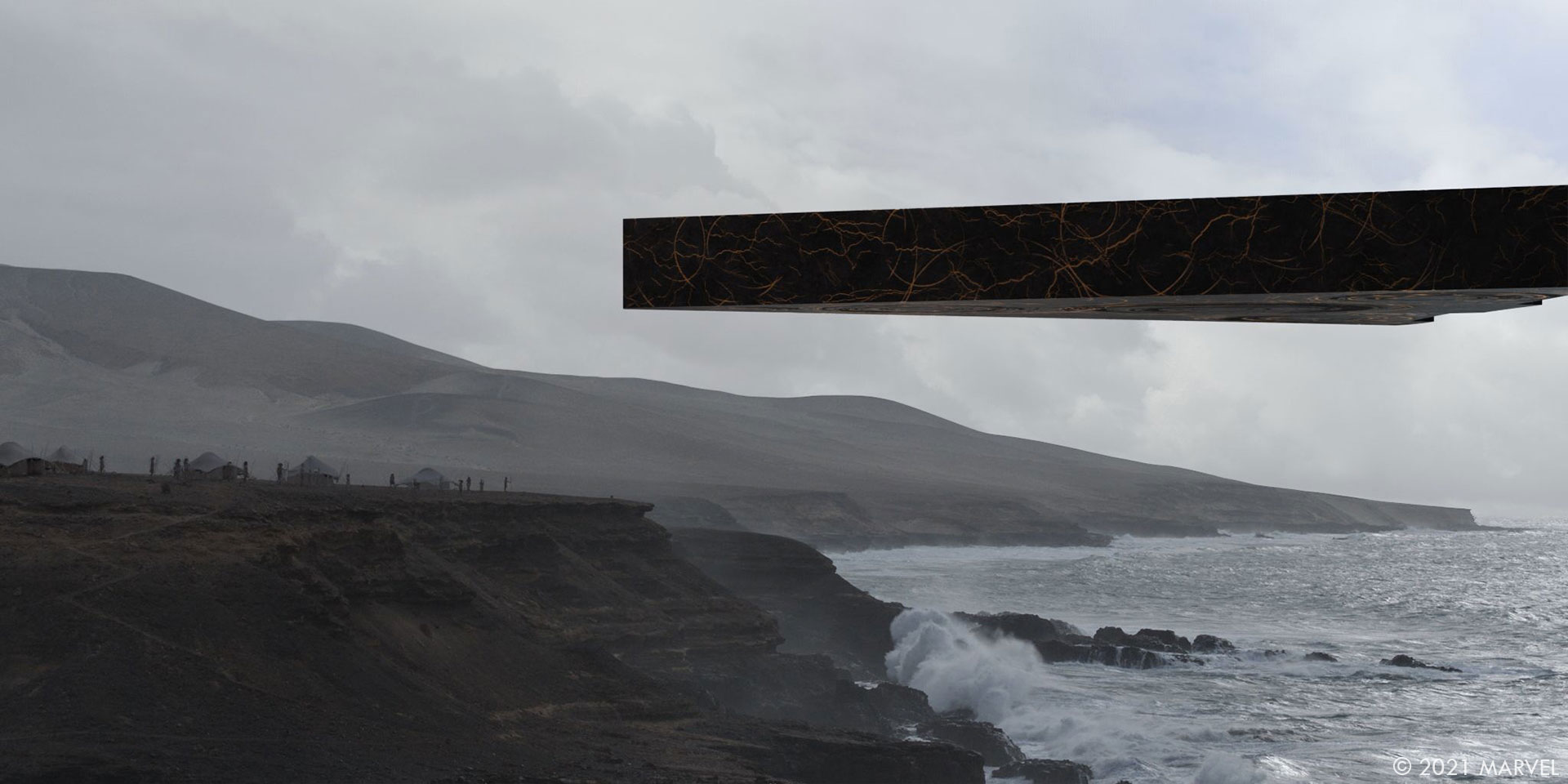
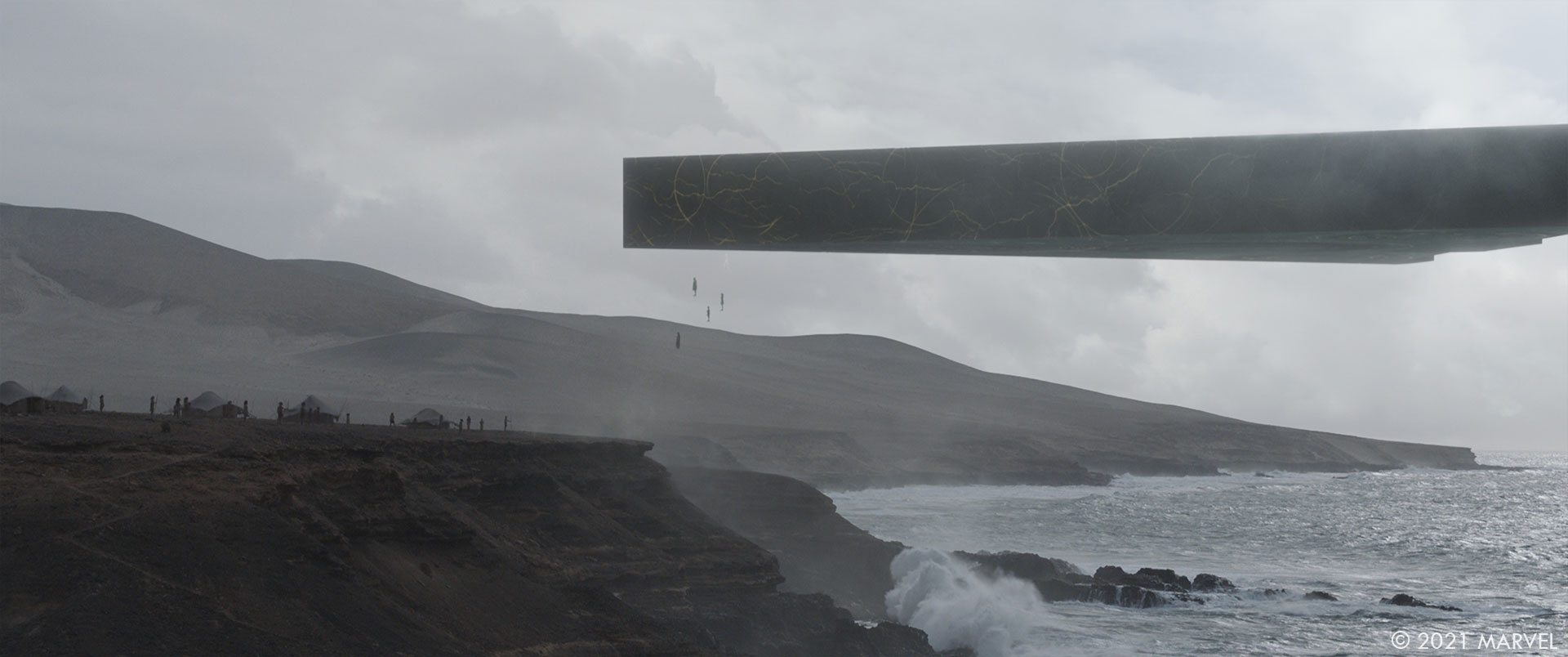
How was the work split between the various ILM offices?
Claudia Lecaros // The work was split by sequence originally but we also had some shared sequences across multiple ILM sites. The London office worked on the Druig Compound, Babylon Modern Ruins & Babylon sequences. We also had some shared shots in the Druig Compound & Babylon sequence with our San Francisco office. The Singapore office worked on the Mesopotamian sequence and the Vancouver office worked on the Alaska sequence and also some of Babylon Modern Ruins. We also built a total of 107 Assets, the majority of which were done by the London office including the Deviants, others were done inVancouver, and Singapore with about 18 shared across multiple ILM offices.
What are the sequences made by ILM?
Daniele Bigi // ILM worked on the “Mesopotamian sequence,” the first sequence in the movie where we see the Eternals landing on earth in 5000 BC on board the DOMO, their monolithic spaceship.
“Babylon sequence,” an action-packed sequence staged in 575 BC, outside the iconic Ishtar gate. The Eternals combine their abilities to kill many deviants including Deviant Bull, one of the stronger and bigger Deviant.
“Alaska sequence,” a critical turning point in the story, where we witness the struggle of Ajak to survive the attack of the ancient deviants, including Kro. In the majority of the shots the entire environment has been completely replaced.
“Druig Compound Battle sequence,” staged in the Amazon forest. The longest and more complex sequence ILM did for this project. We witness a massive battle between the evolved Deviants, including Kro and the Eternals. Most of the Eternals superpowers are on display in this sequence.
“Babylon modern ruin sequence” staged in modern-day Iraq. The ILM team worked on a few stunning FX heavy shots where we see the DOMO rising from the ground of the ancient Babylon city.
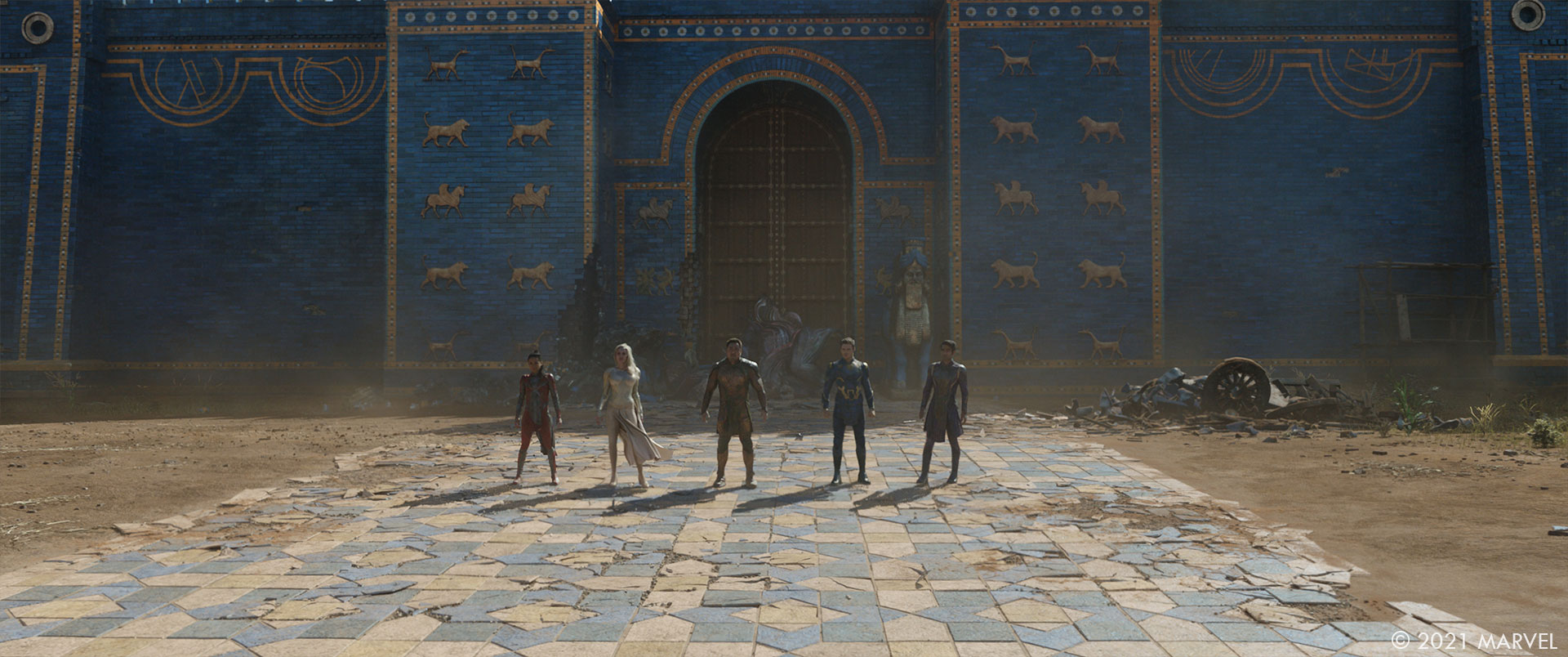
Can you elaborate about the design and the creation of the Deviants?
Daniele Bigi // ILM was in charge of developing almost all of the Deviants featured in the movie, including two of the three stages of Kro, the main villain. Chloé and Stephane wanted to make the Deviants look unique and alien-like.
Everything needed to be unique: from their shape to their size, from their material to how they move. We received several WIP concepts from Marvel. Usually, there is a lot of artistic interpretation to bring any concept to a fully functional 3D creature. In most cases, concept art doesn’t take into consideration all the mechanics of a fully animated creature. On the Deviants, this divergence between 2D concepts and 3D models was more apparent than on any other projects I worked on. I remember Pete Kyme (CG supervisor), Daniel Brkovic (Modelling lead), and me being puzzled at first. We were staring at those beautiful concepts, and in some extreme cases, we couldn’t be sure if we were looking at a leg, a tail, or intertwined tentacles!
Stephane was keen to maintain this unique look. During a call, he asked us to make the deviants partially asymmetrical to match the concepts. Clearly, we couldn’t build them in the “typical manner.” Usually, the body of organic creatures is made from a single close 3D surface. This surface can be as complex as we need it to be, but at the end of the day, it is a single closed surface except for eyes, claws, and a few other anatomical features.
All the Deviants are different, and we built them from the inside out. They are made of dozens of closed surfaces. Some of the surfaces are free to move like the tendrils structure. Others are interconnected and fused like in realistic animal muscles. The best way to describe it is to imagine building a creature muscle by muscle, bone by bone, from the organs to the outer body. After that, imagine selectively removing some of those muscles to create gaps and negative spaces. The result is a beautifully sophisticated shape. While they move, we can see all the inner parts and the dynamic of each muscle. The Deviants needed to be distinguishable from each other while at the same time being coherent in their appearance. We wanted them to look both incredibly strong and agile.
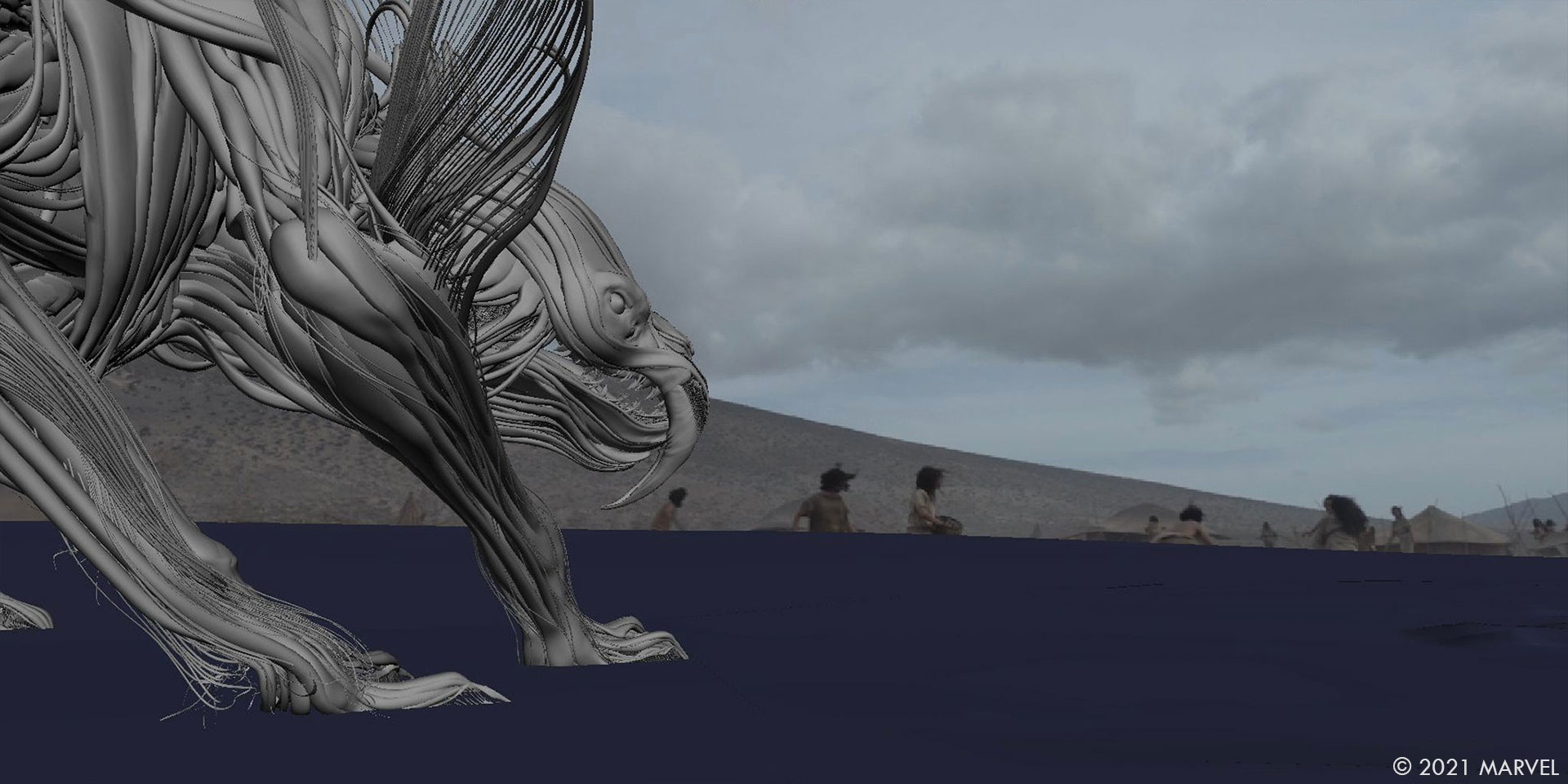
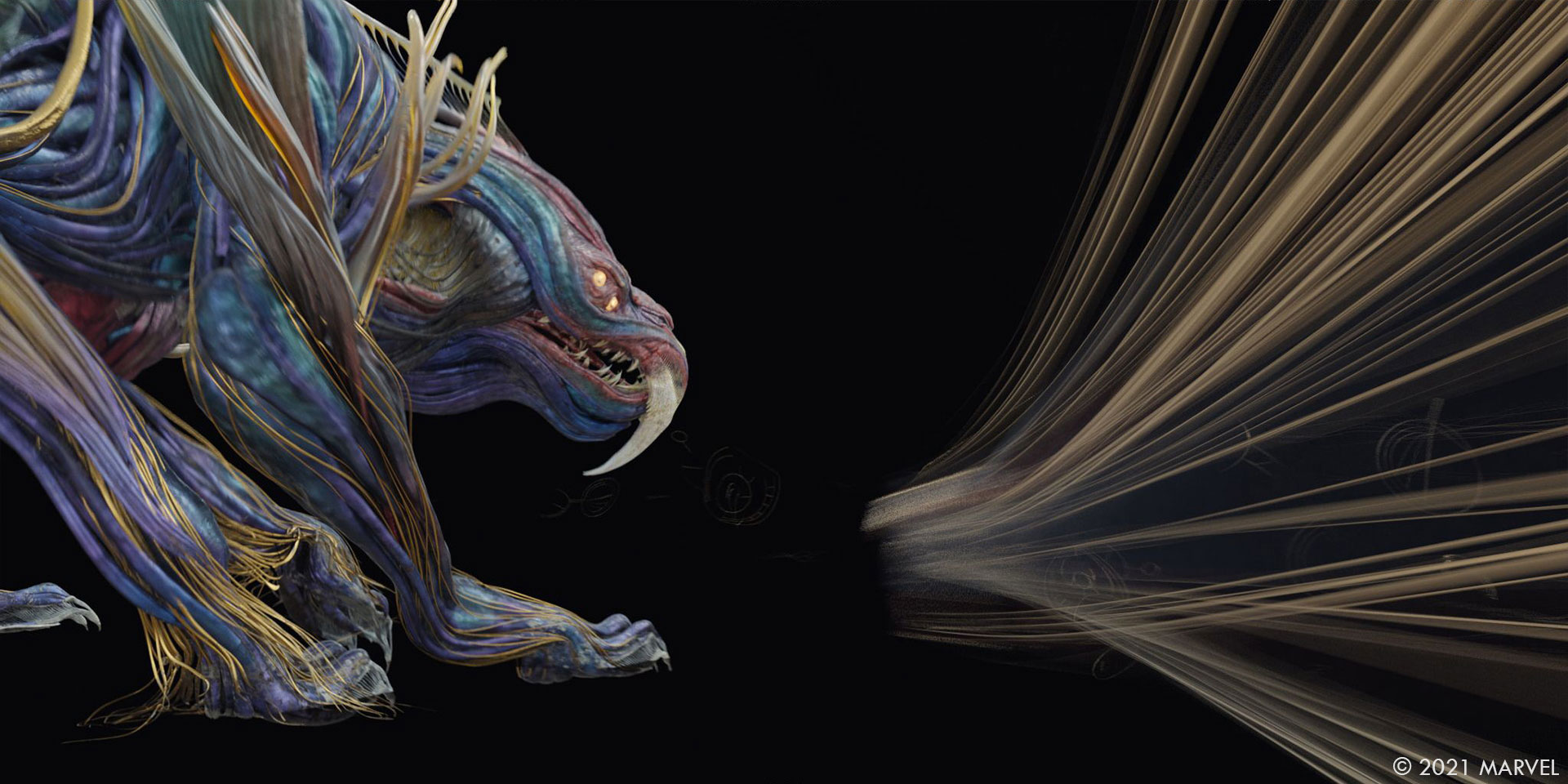
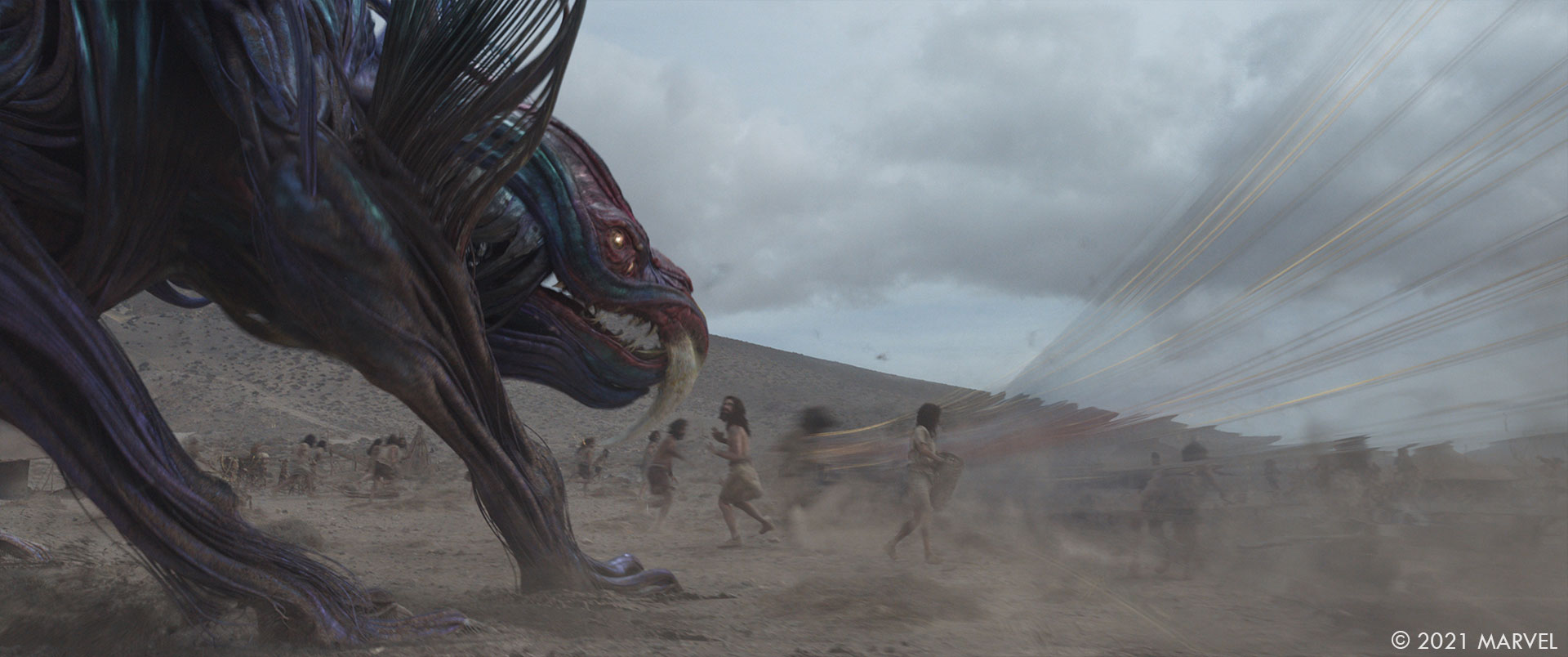
During the movie, they evolved, becoming stronger and more intelligent. Every creature posed a specific design opportunity due to their variety of size, proportions, and anatomy: some were as small as a dog, while others were as big as a mammoth like Deviant Bull A few resembled quadrupeds, and others had six legs and wings! ILM’s London-based art department, supervised by Jason Horley, designed some Deviants from scratch. One example is the Deviant Aqua Leviathan featured in the Mesopotamian sequence, work led by Nigel Sumner, Visual Effects Supervisor in ILM’s Singapore studio. For this Deviant, we ended up with an enormous beast that could swing and walk like a large amphibious and transform his dorsal fin into large wings and fly. The look development for the Deviants started with several turn-tables under different lighting conditions. We used RIS leveraging our LAMA shading system. I identified three different material properties: the outermost layer was made of translucent skin. Underneath the surface, we simulated a metallic iridescent material and then shaded the very long thin tendrils with golden material.
The gold represents Celestial energy trapped within the Deviants’ bodies. At one point, Chloé asked what it might look like to have glowing golden organs. Once we saw it we determined that it was too distracting, especially in the relatively dark Amazon jungle featured in the Druig Compound Battle sequence. A huge thanks to Stevie Denyer, senior Look Development Technical Director; he did a fantastic job combining complex materials behaviors while keeping the shader physically plausible.
Kro is the main villain, and he took the better part of a year to build! He did share many characteristics with the other deviants. He is made of dense muscle tendons and tentacles that could extend from his limbs to perform attacks and other actions. During the movie, Kro evolves twice, transforming his entire body and face. ILM was in charge of developing the first two stages of his evolution. Weta Digital took care of the final stage.. We also worked on the final transformation shot from the second to the third evolution. One of the many creative challenges was to design three different bodies with different anatomical features while keeping the design coherent and recognizable. Every time Kro transforms, his body gets closer to a humanoid shape. His behavior and the style of the animation needed to reflect this aspect as well. During the Alaska sequence, his body silhouette is similar to an enormous quadruped, and when he is transforming to the second form he becomes smaller and more agile. His second form is heavily featured in the “Druig Compound Battle” sequence. In this sequence, we wanted to make sure the audience realized how much the second form evolved from the first. Animator supervisor Mathieu Vig and his team did a fantastic job playing with the idea that the second form was temporally trapped in an in-between stage. During the sequence, the second form uses his back tentacles in more intelligent ways to attach and fight against the Eternals.
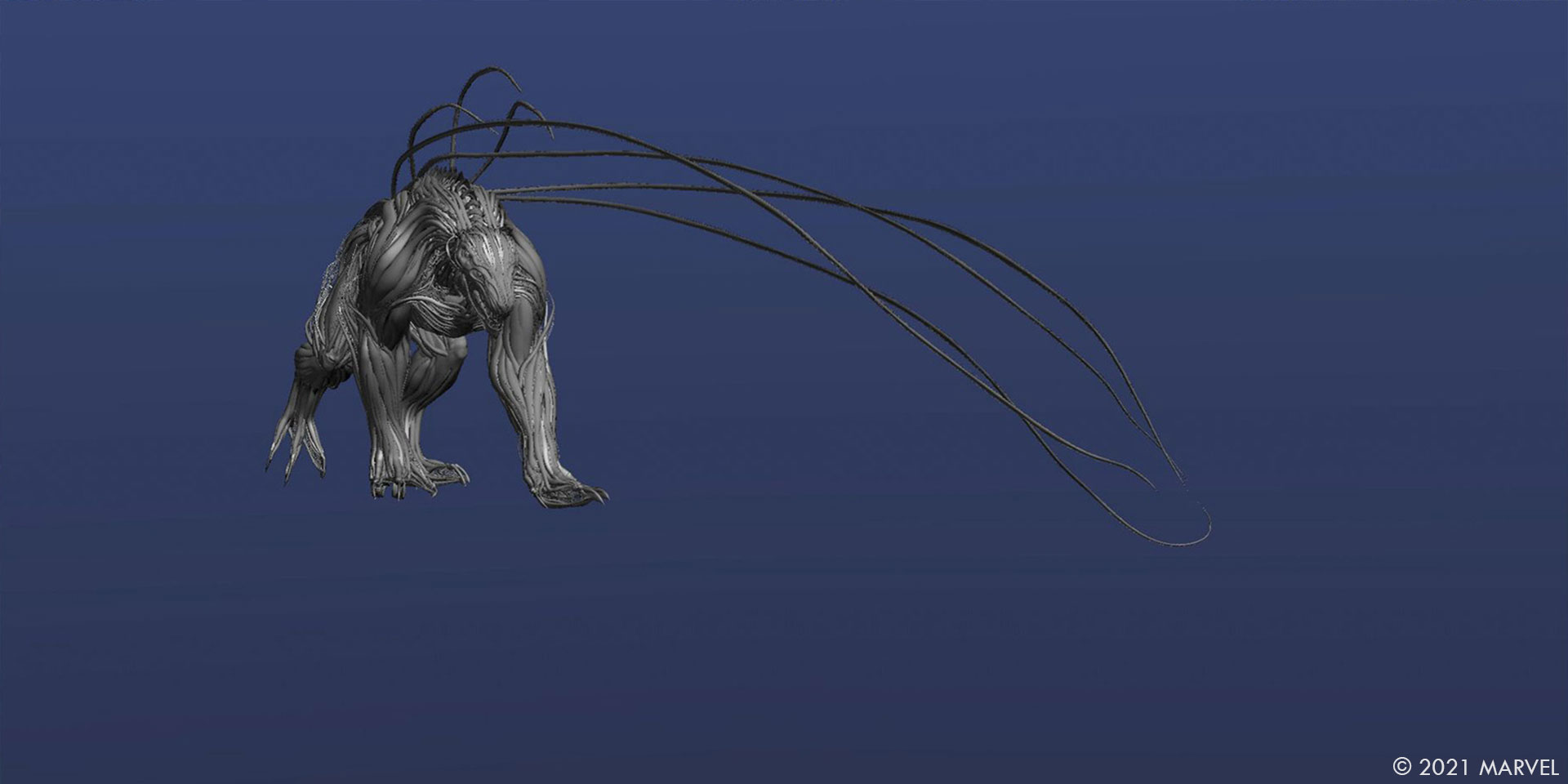
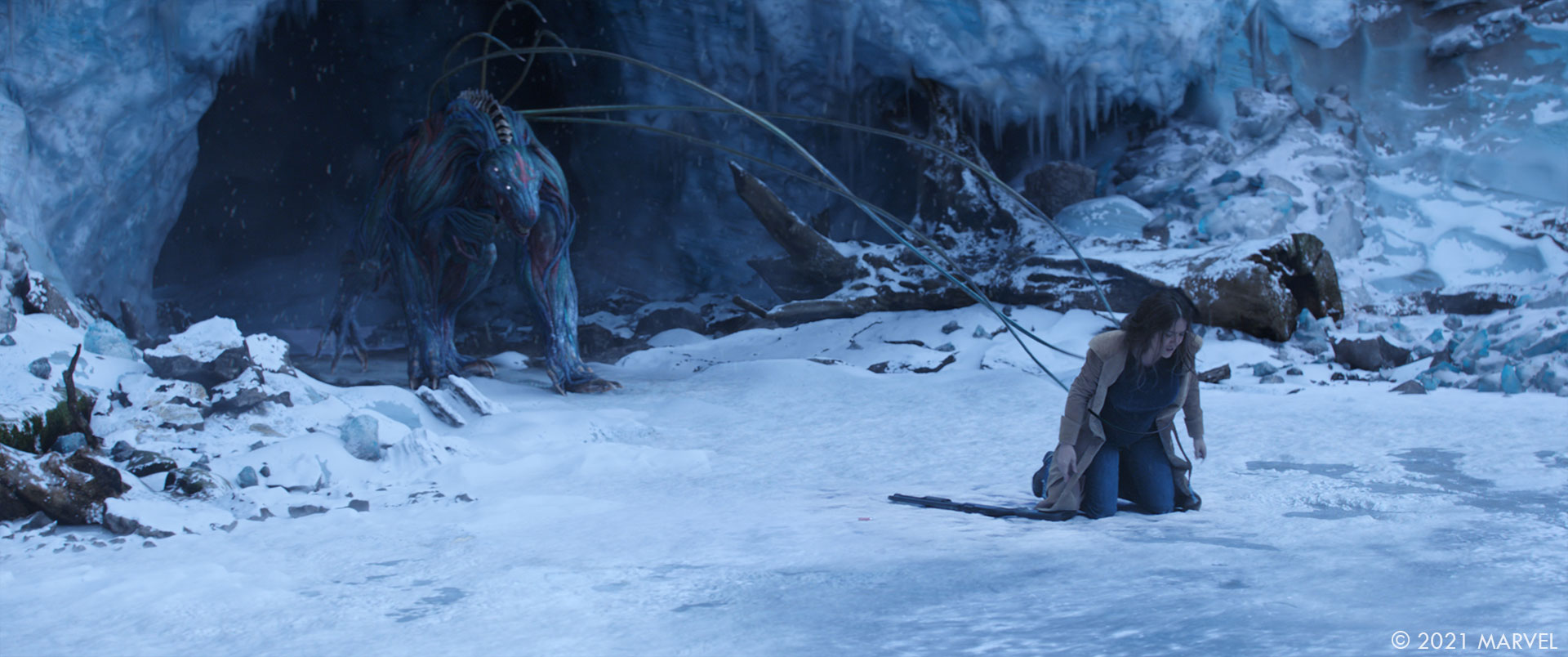
Pete Kyme // The Deviants were incredibly complex to design and execute, pushing each department to the limits. A key early creative decision was to allow the individual tendrils that form the body to behave independently in animation and simulation. This resulted in extremely detailed models with thousands of individual meshes. Custom procedural tools were built to support the creation of fine repeating structures seen in the original concepts.
The designs also posed unique challenges in rigging and muscle simulation for our creature team. Each Deviant supported a behaviour we named the “Mononoke Effect”, where individual muscle tendons flex and pulse in waves. A complex system of deformers was developed to put expressive control of this effect in the hands of our animators. In addition, new rig components were developed to allow detailed control of longer individual tendrils found in many of the designs.
The transformation shots also required very close collaboration between our creature, modelling and animation teams to pull off. The transformation seen at the end of the Druig Compound sequence required a seamless, art directed transformation between two unique designs with no shared topology, and building the transformation rig was one of the bigger challenges on the project.
For simulating the muscular structure of the deviants, our creature team devised a layered approach where clusters of fibers could be simulated as a larger muscle mass, contracting and flexing during animation as with a traditional creature. Then additional layered simulations allowed for separate movement of the individual fibers, emphasising the complex structure of the Deviants.

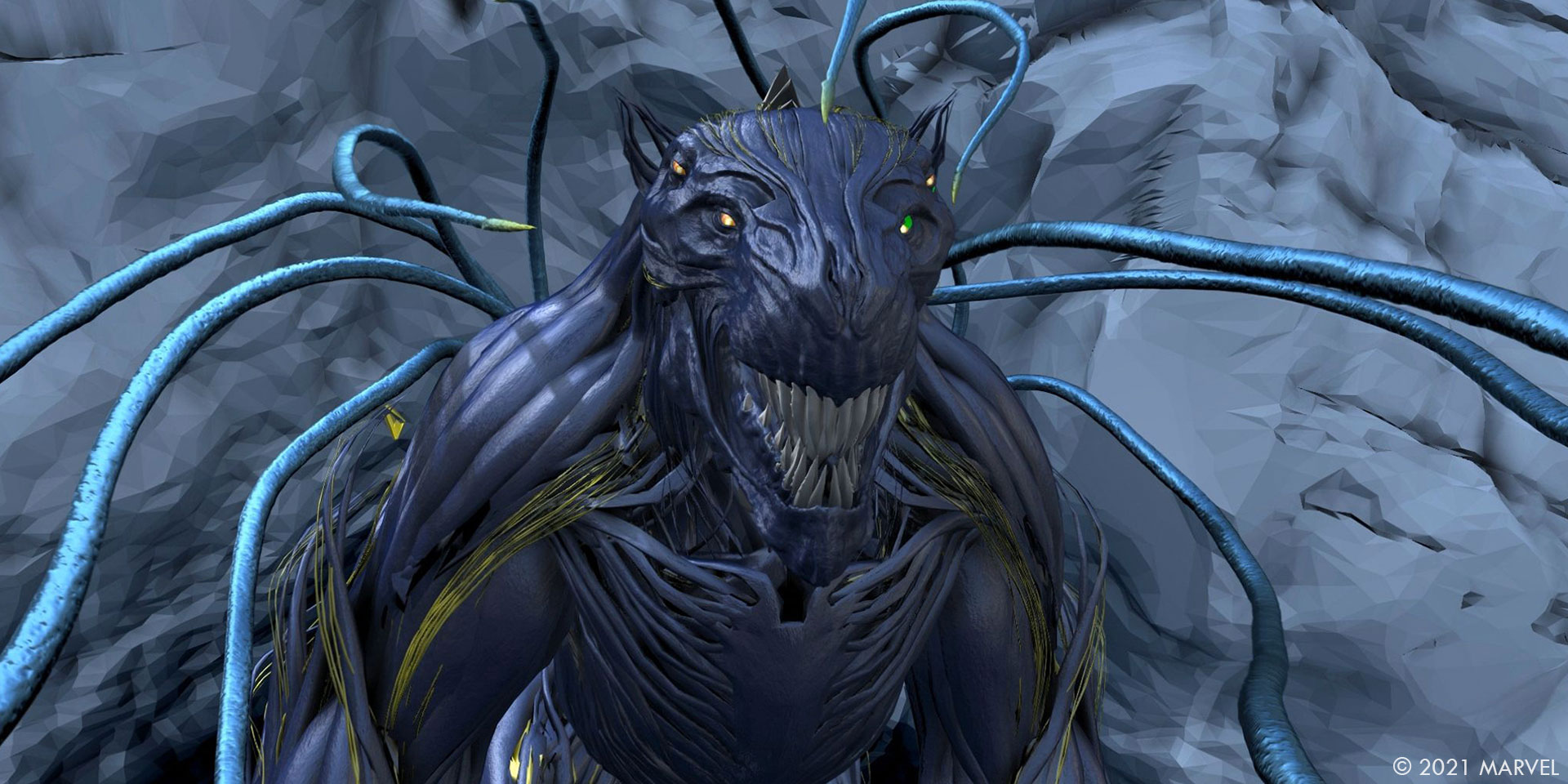
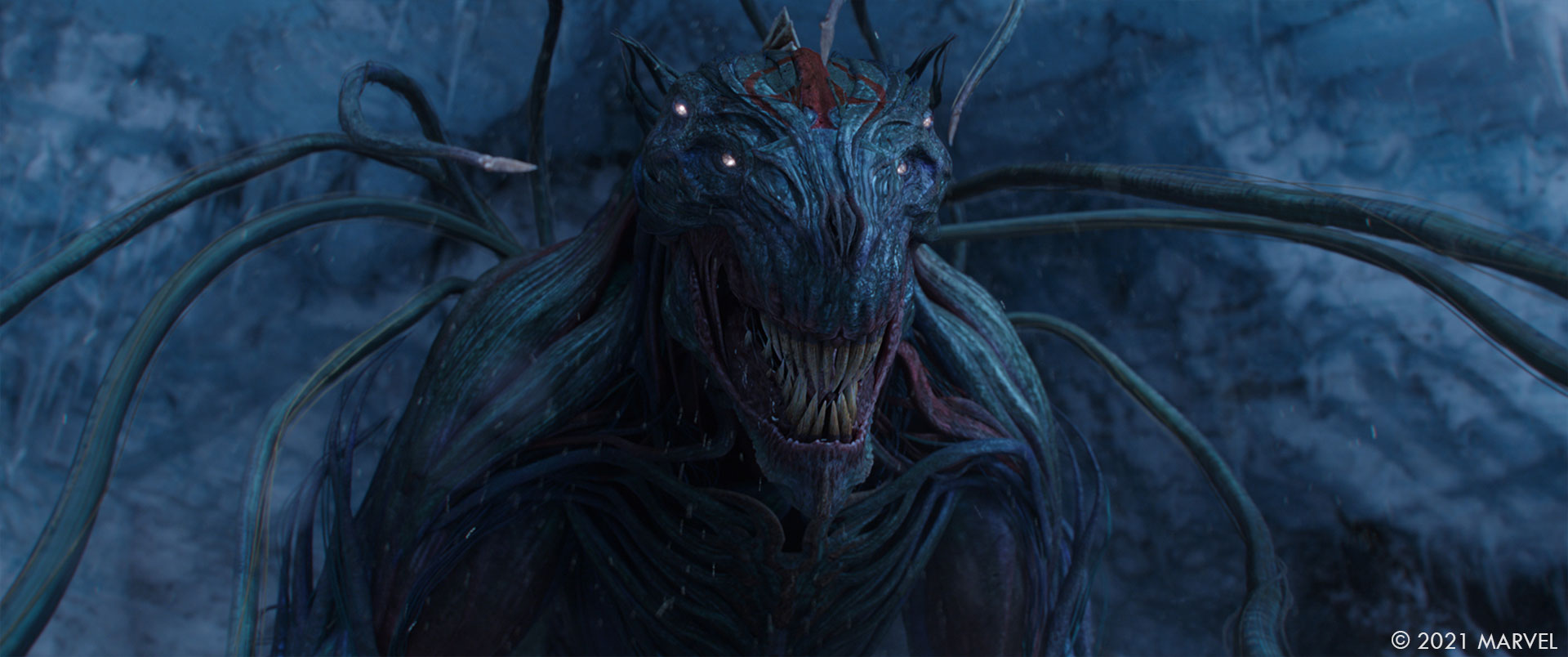
Can you tell us more about their animation?
Mathieu Vig // The Deviants are inspired from different apex predators, so we wanted to take inspiration from real life animals like bulls, eagles, tigers, while giving them a supernatural ferocity, strength and speed. We wanted to find the right balance in their motion to make it clear that only the Eternals would be able to take them on.
Kro, the deviant pack leader on the other side was going to be much stronger than the rest of them but also much more aware and intelligent. So we made him move in a more controlled and restrained way to show his confidence in his own strength, even if he could have bursts of really fast and heavy motion. His tentacles were also an interesting challenge for the animators, they had to feel sentient while strong enough to wound or hold the powerful eternals. We used a mix of simulation tools driven by the animators, mixing it with keyframes for the more precise actions they had to take.
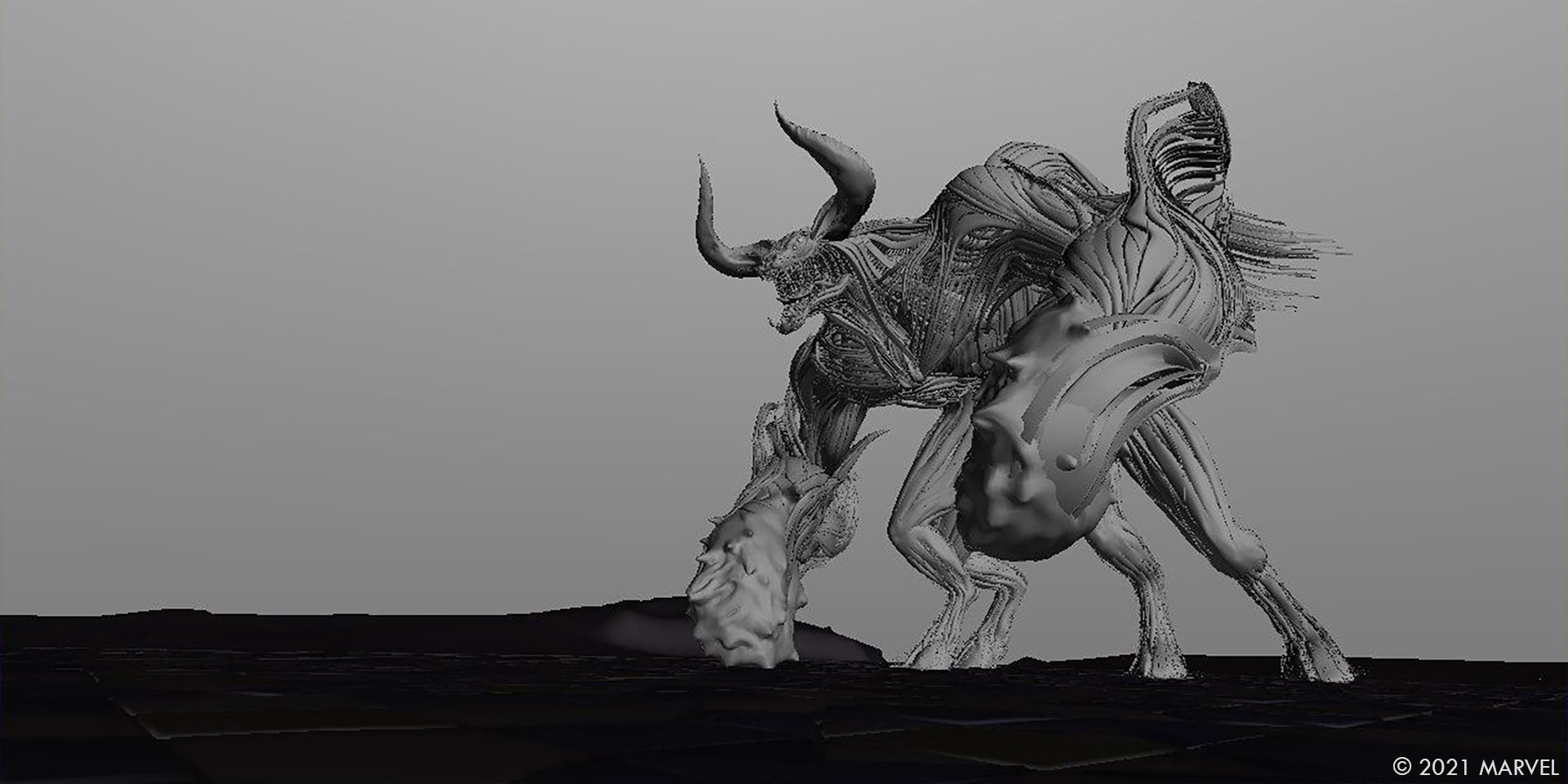
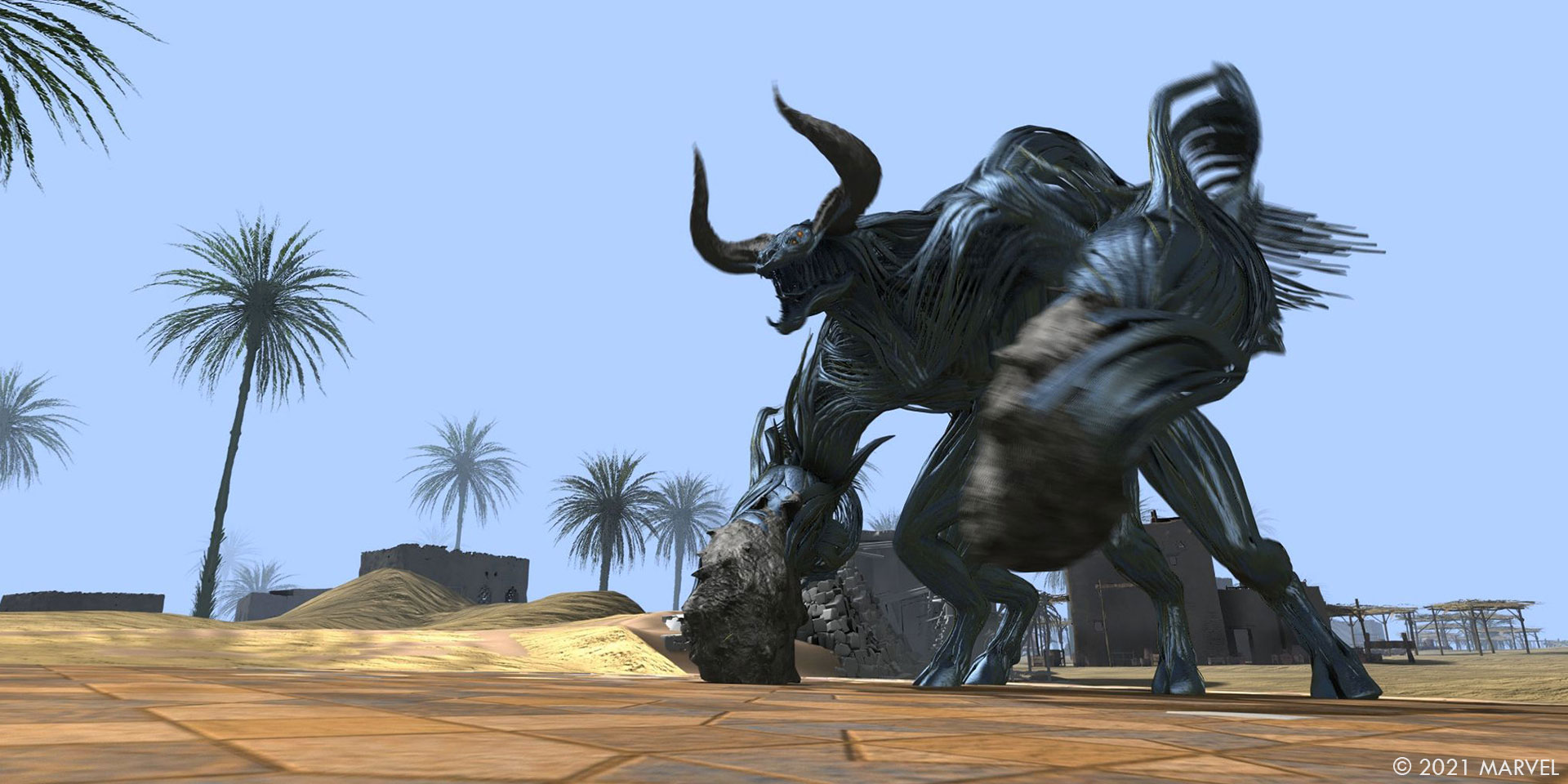
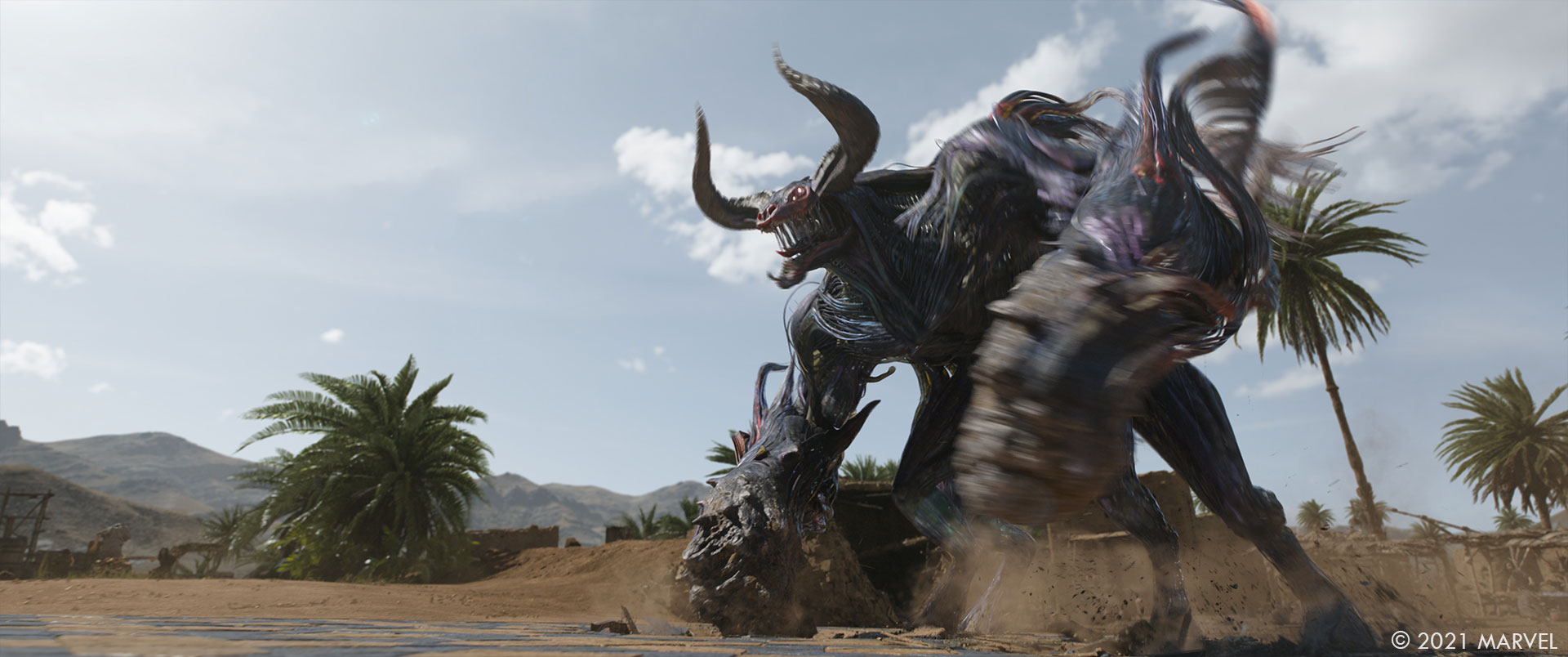
Did you receive specific indications for their animations?
Mathieu Vig // Every shot had to feel relentless, fast, and very powerful. We were showing every animation with temporary effects and destruction elements to help illustrate what the final shot would feel like and the scale of their strength. But mostly, they had to feel like real animals with believable, naturalistic motion, even if their designs were quite out of this world. For Kro there was a lot of back and forth with the director about how human we would show him after his first transformation, he could stand on two legs and be very humanoid, but we decided to bring him down to four legs for most of the sequences to save his “human” look for the final transformation.
How did you work with the SFX and stunts teams for the various fights?
Mathieu Vig // We always tried to keep as many real elements from the plates as possible during the fights, but as our models were looking better and better we figured out there were new elements we could re-animate in CG to make the fights more believable and visceral. The actors were always fighting against stuntmens to avoid “faking” being thrown, pulled, punched around which gave us a great base to add our creatures, but as often when cables are used to lift and swing the actors around, there is a slowness to the movements that is hard to sell right. So, bit by bit we would replace and animate an arm, legs, sometimes full bodys and only keep the actor’s face to make every impact more, well, impactful.
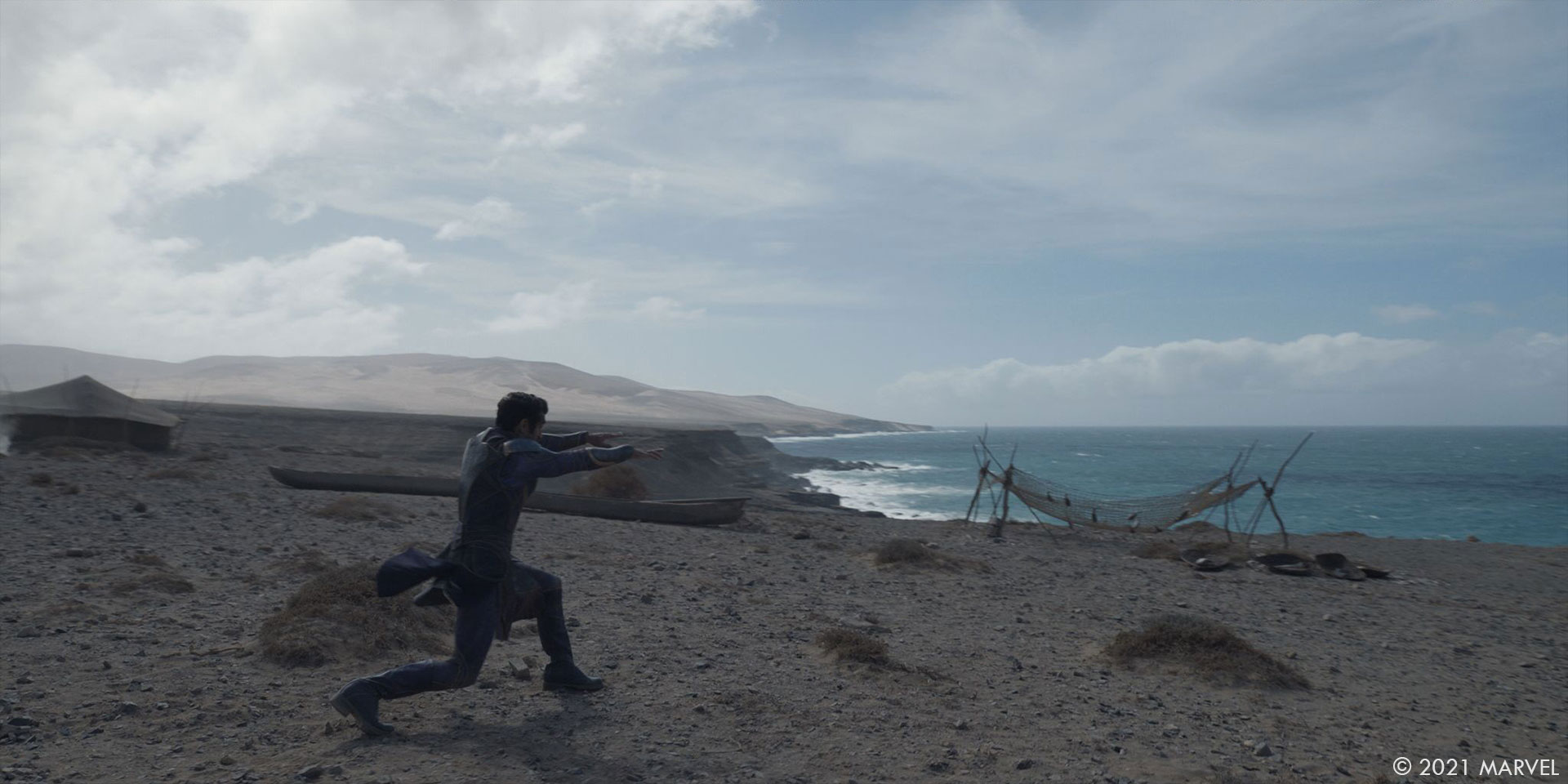
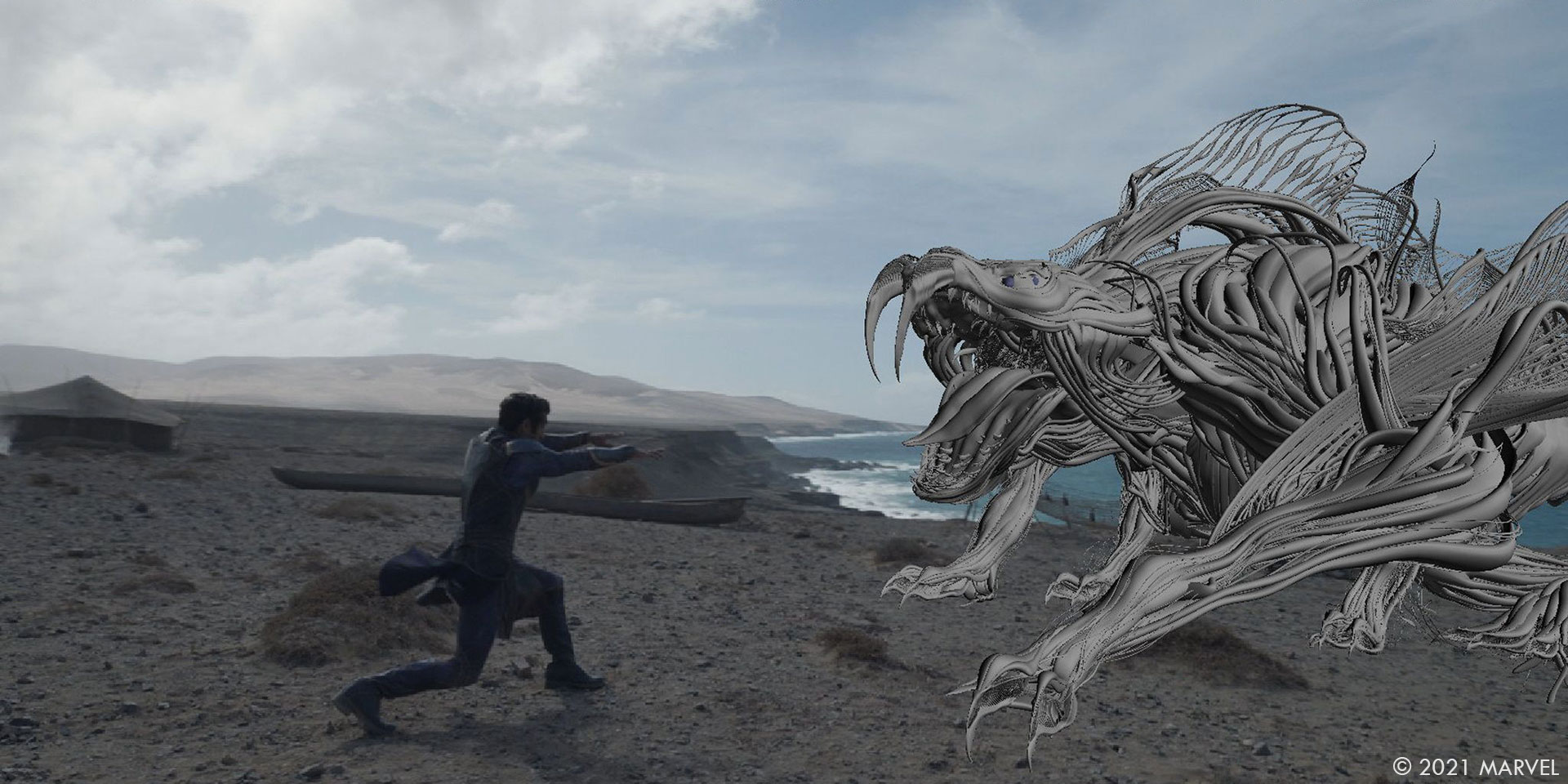
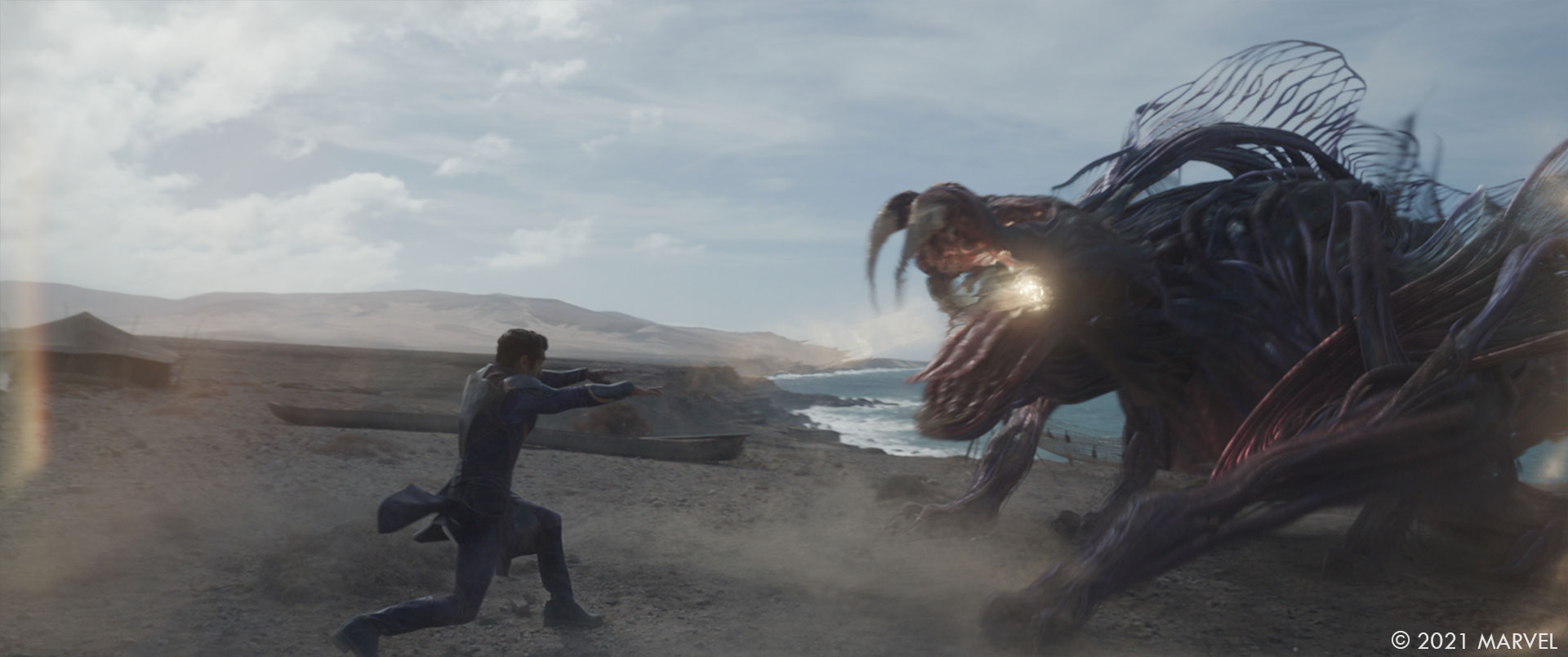
Can you explain in detail about the Eternals’ powers?
Daniele Bigi //
- Sersi can manipulate and transform matter.
- Ikaris can fly, and fire energy blasts from his eyes.
- Kingo can shoot bolts of energy from his finger.
- Phastos can create technology.
- Thena can create weapons out of celestial energy and fight like a goddess warrior.
- Sprite can create any type of illusion.
- Makkari can run incredibly fast and generate sonic booms.
- Gilgamesh can destroy anything with his super punch.
- Druig can control people’s minds.
- Ajak has healing powers, and she can communicate with their creators.
The Eternals superpowers are very different from each other. Since the beginning of the project, I worked with Stephane and the team worked to find a visual language to connect them all. Celestial energy was the answer. It is the common element between all the superpowers. All the Eternals are sourcing the Celestial energy within their body, channeling it in different ways. We needed to somehow visualize the energy. We took inspiration from the beautiful work done by the American comic book legend Jack Kirby, the original Eternal comic-book creator. Kirby developed a specific way of drawing, and a distinctive “pattern” emerged from his style. The FX team, led by FX supervisor Tobias Keip, started to work on a tool to re-create in CG this iconic pattern (internally named: Celestial pattern). We needed to have complete artistic control: this pattern, made of 3D curves, required to be scaled at any size, grow at arbitrary speed, flow in any direction, wrap around any surface, etc. We ended up with a perfect, controllable procedural tool. This work became the building block to create all the Eternals superpowers. For example, Sersi (played by Gemma Chan) can change matter. This superpower manifests with Celestial energy spreading from her fingers and wrapping around objects while the matter changes. Every curve that made the pattern was converted to geometry and shaded as gold. Along the curves, the energy flows, and over a certain threshold, it starts to glow and emit light.
Ikaris eye beams superpower uses the same visual style. Ikaris shoots golden lines that are clustered together. They move in one direction at a very fast speed. When the beams collide with the ground, the lines slow down, and the pattern emerges revealing the true nature of the energy.
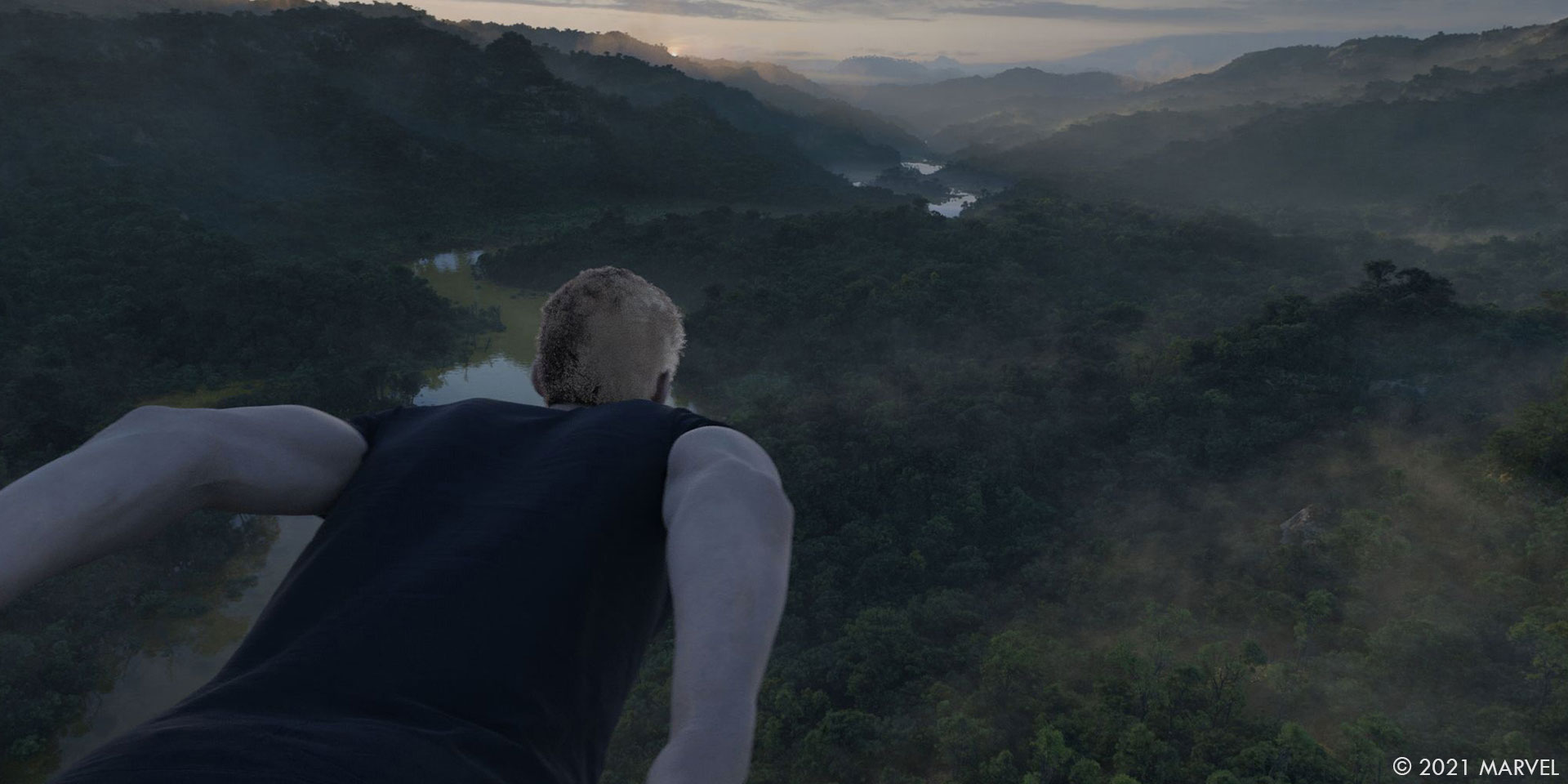
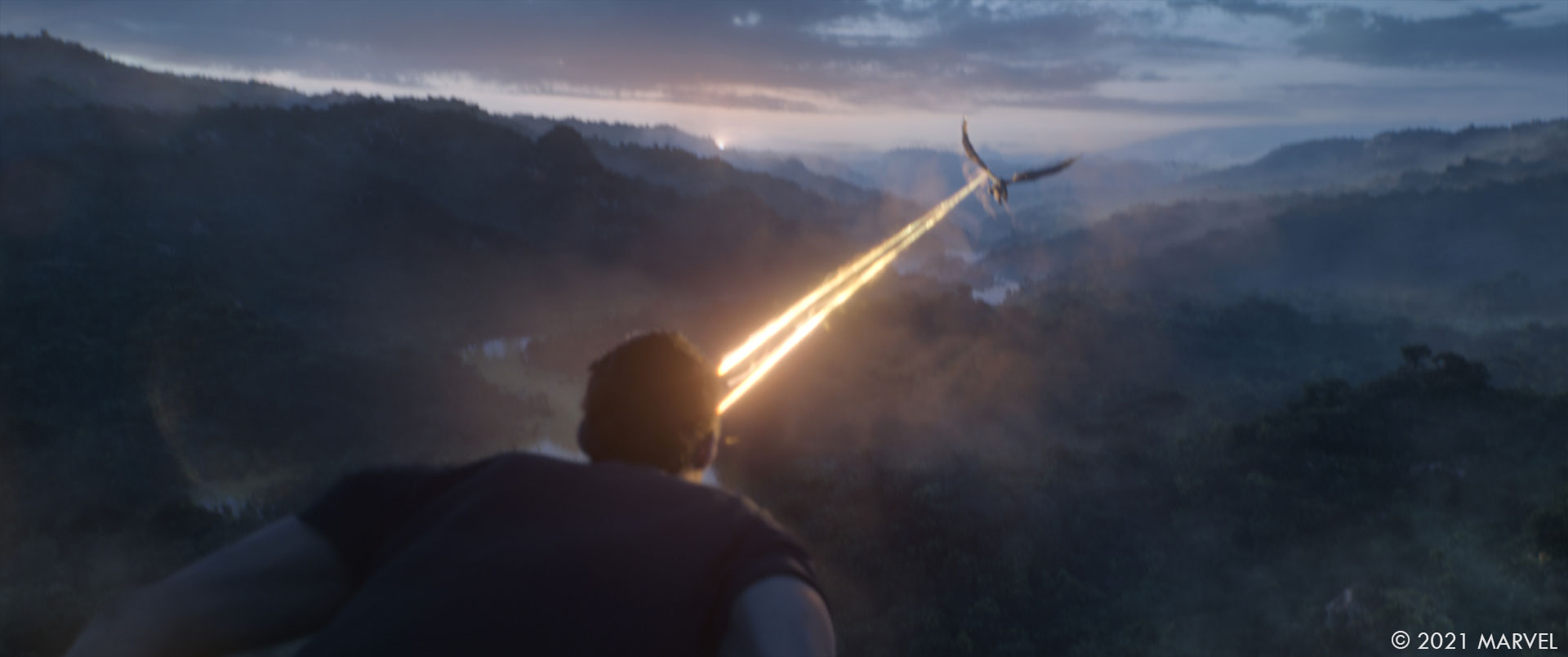
Can you tell us more about Thena weapons?
Daniele Bigi // Thena, (Angelina Jolie) can create any type of Celestial weapon. We received several designs from Marvel and developed a few internally at ILM. The overall silhouette of all the weapons resemble classic shapes inspired by Greek mythology. We modeled the base shapes, and using our procedural tool we made the Celestial pattern to grow along the underline 3D shape. The tool allowed us also to shapeshift between weapons as well.
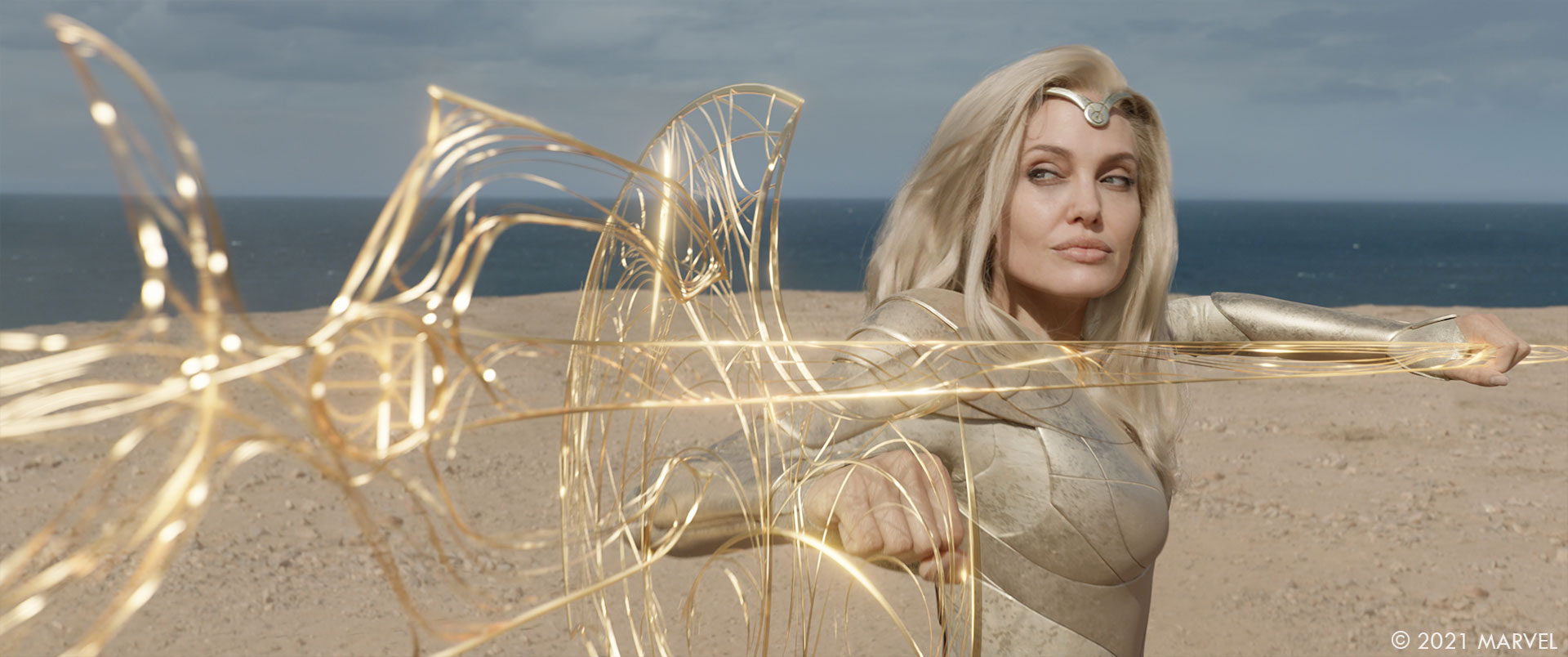
How did you create the various environments?
Daniele Bigi // Our environment team played a significant role in this project. Supervised by Clement Gerard, the team has been involved in several sequences with very different tasks. One of the biggest challenges was the reconstruction of Babylon city and its surroundings. It was clear that very little of the city could be constructed. We digitally recreated the entire city, completely replacing the small gate and a couple of statues built on location. We recreated the surroundings, including the Eupraphers and the Tigris rivers, Babylon’s ziggurat, the hanging gardens, several villages, and miles of fields. We started with DEM data (digital elevation map) to generate the mountains and land around it, recreating the look and the feel of ancient Mesopotamia.
It was important for the director, Stephane, and myself to ground the city into reality. We didn’t want to recreate a historically perfect representation, mainly because there isn’t enough archaeological material and historical documentation to do that. Even if my team and I had freedom in designing the city, I believed it was imperative to collect as much reference material as possible. I contacted the British Museum in London and the Pergamon Museum in Berlin and collected thousands of reference photos. From statues to wooden doors, from capitals to pottery, from jewels to everyday tools.
During the shooting at the Pergamon, we captured a lot of data of the Ishtar Gate. We rebuilt every detail of the gate and extrapolated many other architectural elements from the reference material. The fantastic environment team ingested life into the city. We added thousands of civilians, animals, and scattered open VDB caches from our library to simulate dust, smoke from wood burning, etc.
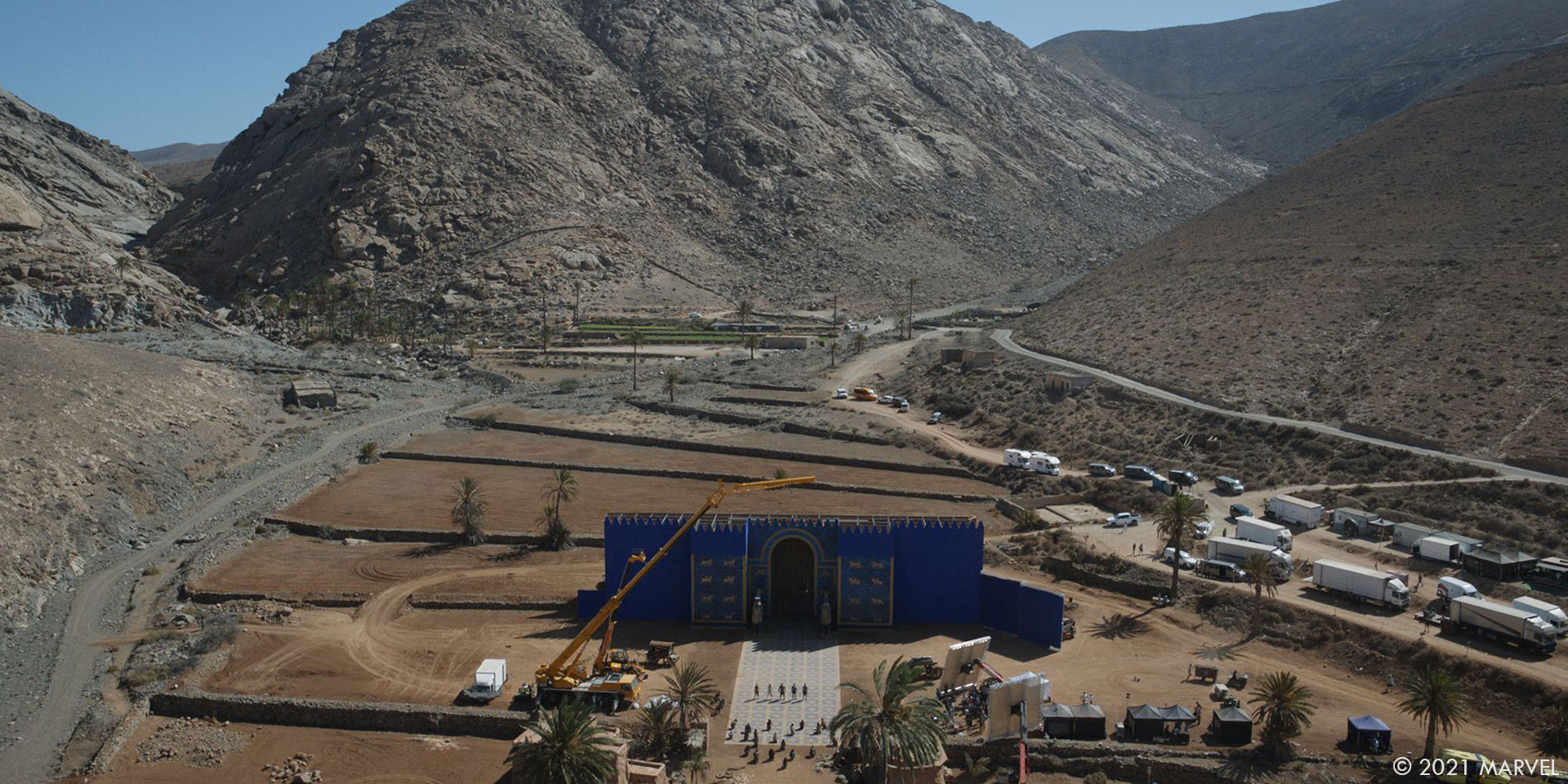
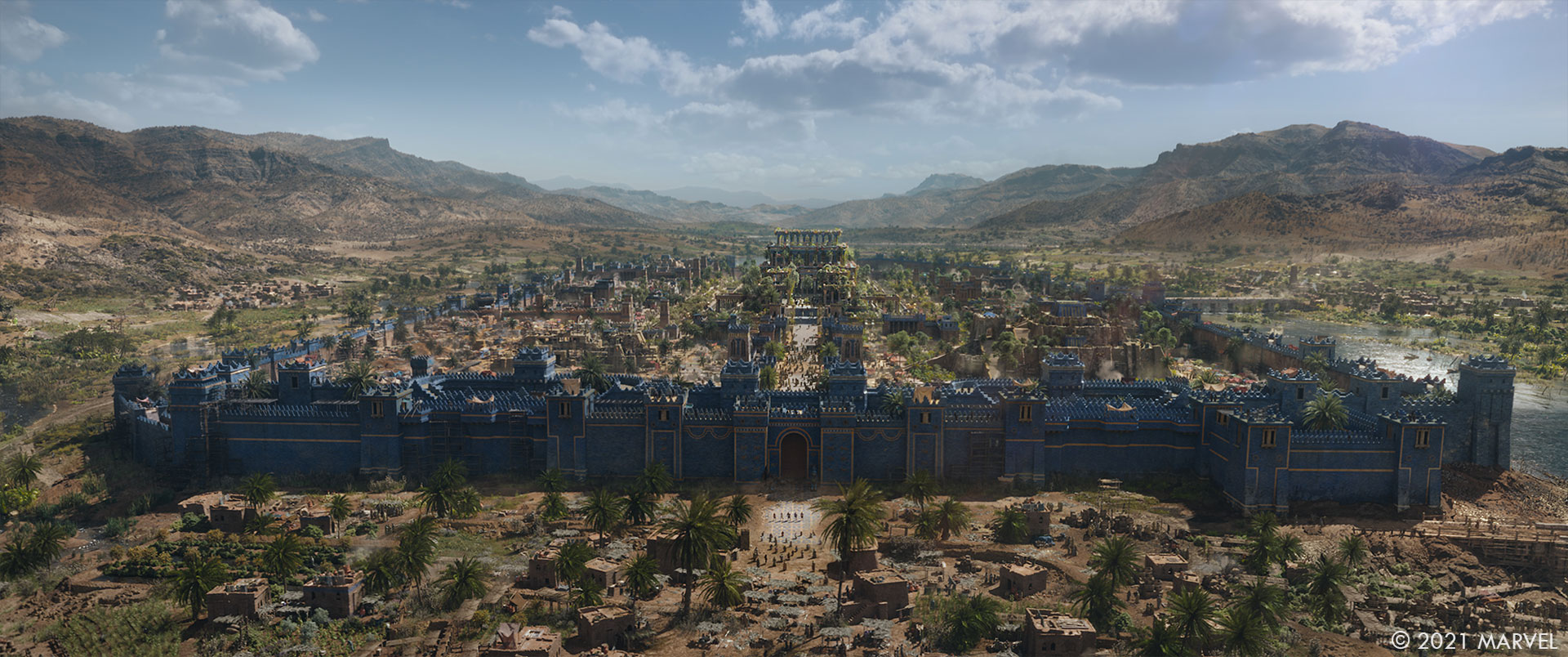
Probably, the second biggest task was recreating the Alaska environment. The team at ILM’s Vancouver studio executed this work, led by VFX supervisor David Seager. At the beginning of this sequence, Ikaris and Ajak chat near the edge of a massive cliff surrounded by a beautiful frozen lake. In the second part of the sequence, Ajak is fighting for her life against the primordial Deviants. This sequence was filmed on location in the UK. We could keep only the actors and a small portion of the terrain and trees. I spent a few days in Lehesten, Germany, with a stoic capturing team. On paper, the location was exactly what we needed: an abandoned quarry with a vast man-made cliff. Due to the excavation and the terrain’s inclination, a relatively large frozen artificial lake was formed. Luckily it also featured a small opening at the base of the cliff. This hole was a perfect spot to stage the reveal of Kro01 and his first transformation. We scanned every inch of the place.
During post-production, the idea of what this set was supposed to be, evolved into something with a much larger scale. Stephane and Chloé wanted the cliff to be at least twice as tall and 4-5 times as long. The lake needed to be extended by a few kilometers, and an oil refinery was added. We also wanted the weather to be much harsher. We added CG snow falling, and we covered the ice lake with a layer of snow. We ended up building a 360-degree digital set!
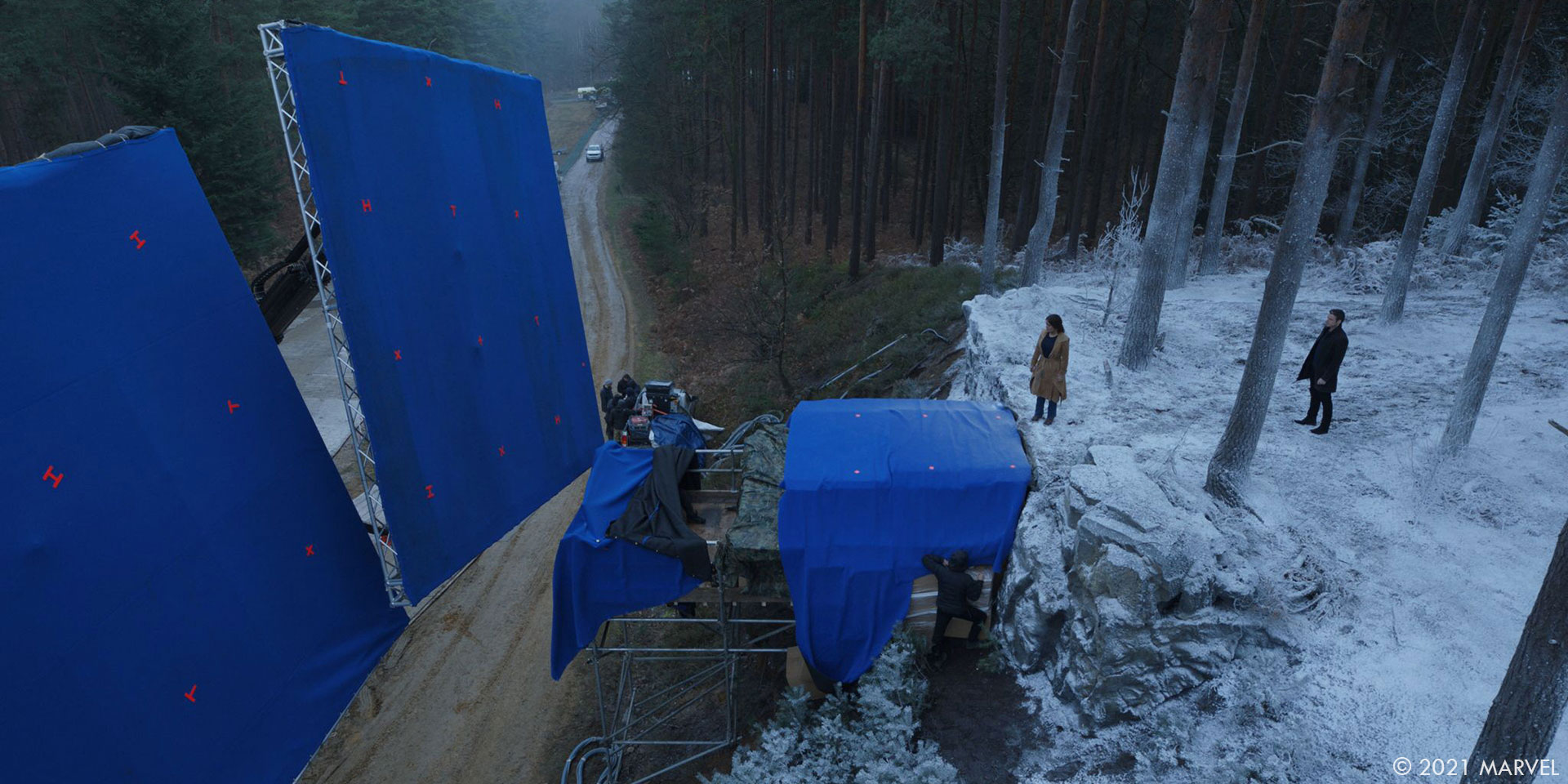
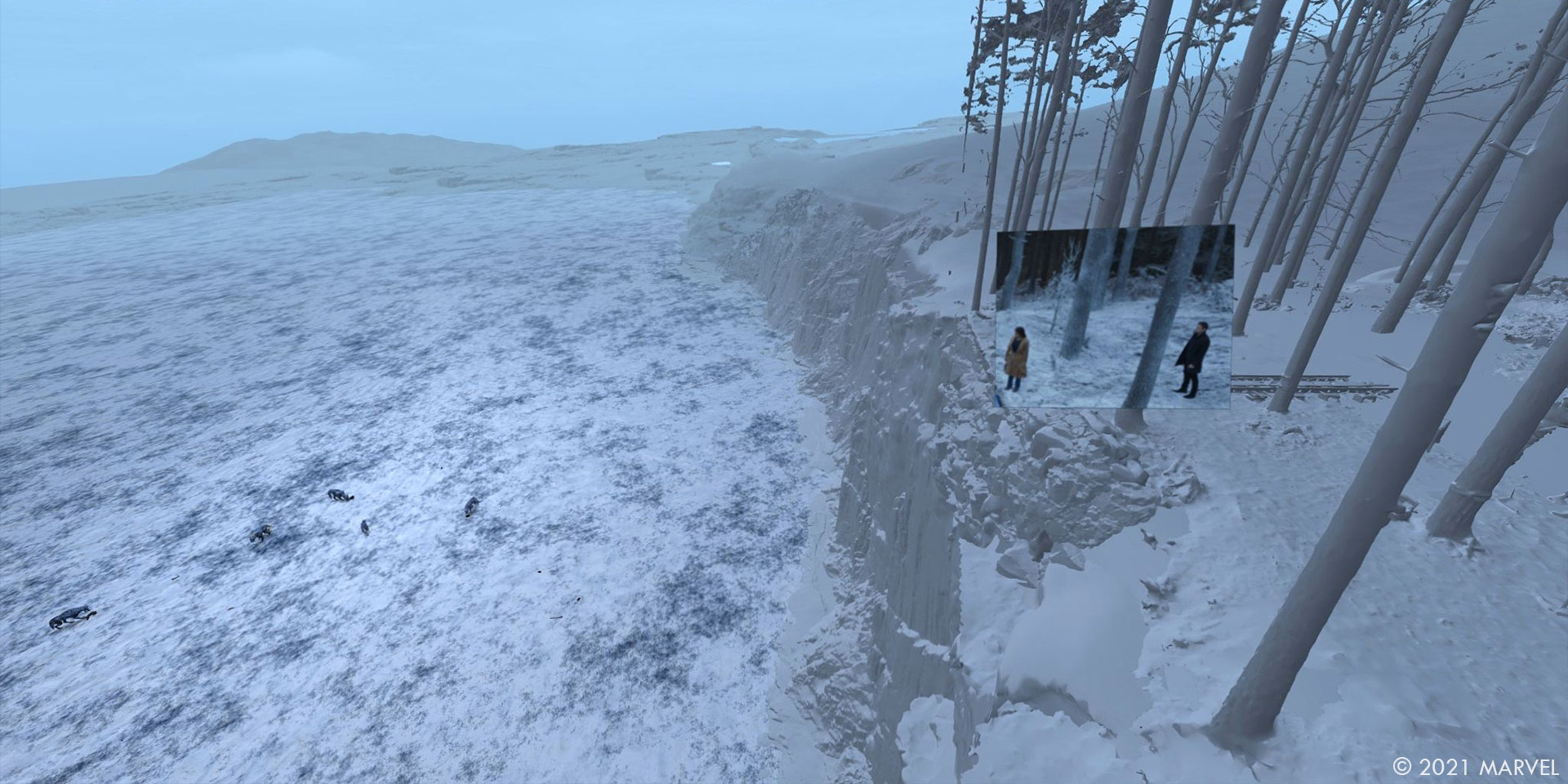
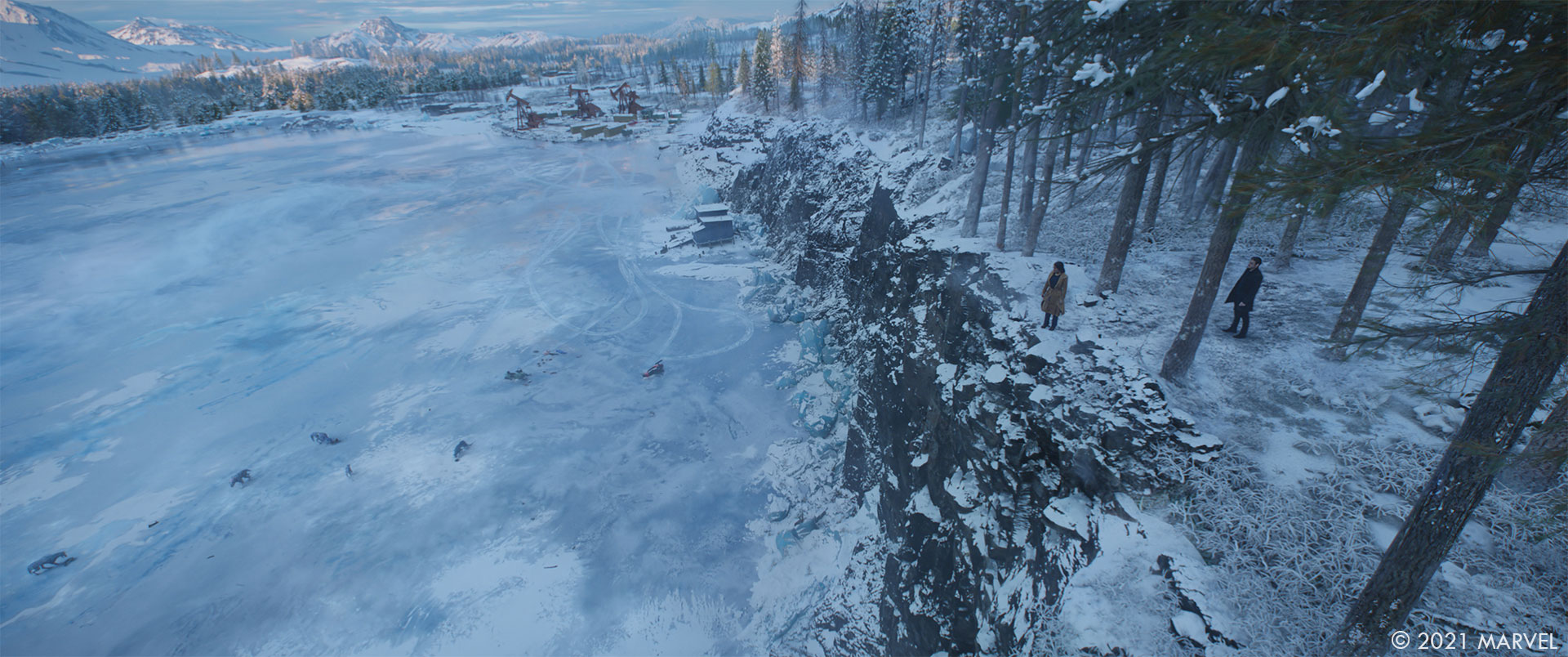
Which shot or sequence was the most challenging?
Daniele Bigi // Without any doubt, the Druig Compound Battle sequence. Not only is it the longest sequence we worked on, but there are also so many shots with many different Deviants interacting with the environment and the actors. We see most of the Eternal utilizing their superpowers in many ways, so every shot was different! On top of that, we see the most challenging shots with Kro’s second form, the fight with Gilgamesh, and his transformation.
Is there something specific that gives you some really short nights?
Daniele Bigi // I was lucky to be part of an incredibly talented team that made anything possible. If I have to pick something that definitely challenged us, it was Kro’s transformation to the third form.
In my career, I worked on many projects where we needed to transform complex creatures or humans. These shots cannot be underestimated. Even if modern toolsets and workflows are very mature, the skills of individual artists are fundamental. Kro’s transformation was the most complex creature transformation I ever worked on. We had to deal with so many requirements. As mentioned above, Kro was made of so many different closed shapes. Every muscle, tendon, and bone needed to move and shapeshift into specific targets without visible intersections. Daniel Brkovic, our lead modeler, did an amazing job. The topology between the forms was vastly different. Even the number of objects that made them didn’t match at all.
The third form, our target, was built by Weta, and it was delivered to us at a very late stage. Michale Hipp, lead lighting TD, with the help of Stian Halvorsen, senior FX TD, found a way to control the transformation of the shaders while the celestial energy was propagating inside Kro’s body. We wanted to give the animators the freedom to control any aspects of Kro’s posture while he was transforming. When the second form is fully transformed into the third form his facial anatomy is vastly different, and he can talk and emote similarly to a human. All these aspects and more made these shots very complex.
Furthermore, everything is happening across multiple shots from different angles and with the camera very close to his body. I think the result is truly spectacular and I’m very proud of the team!
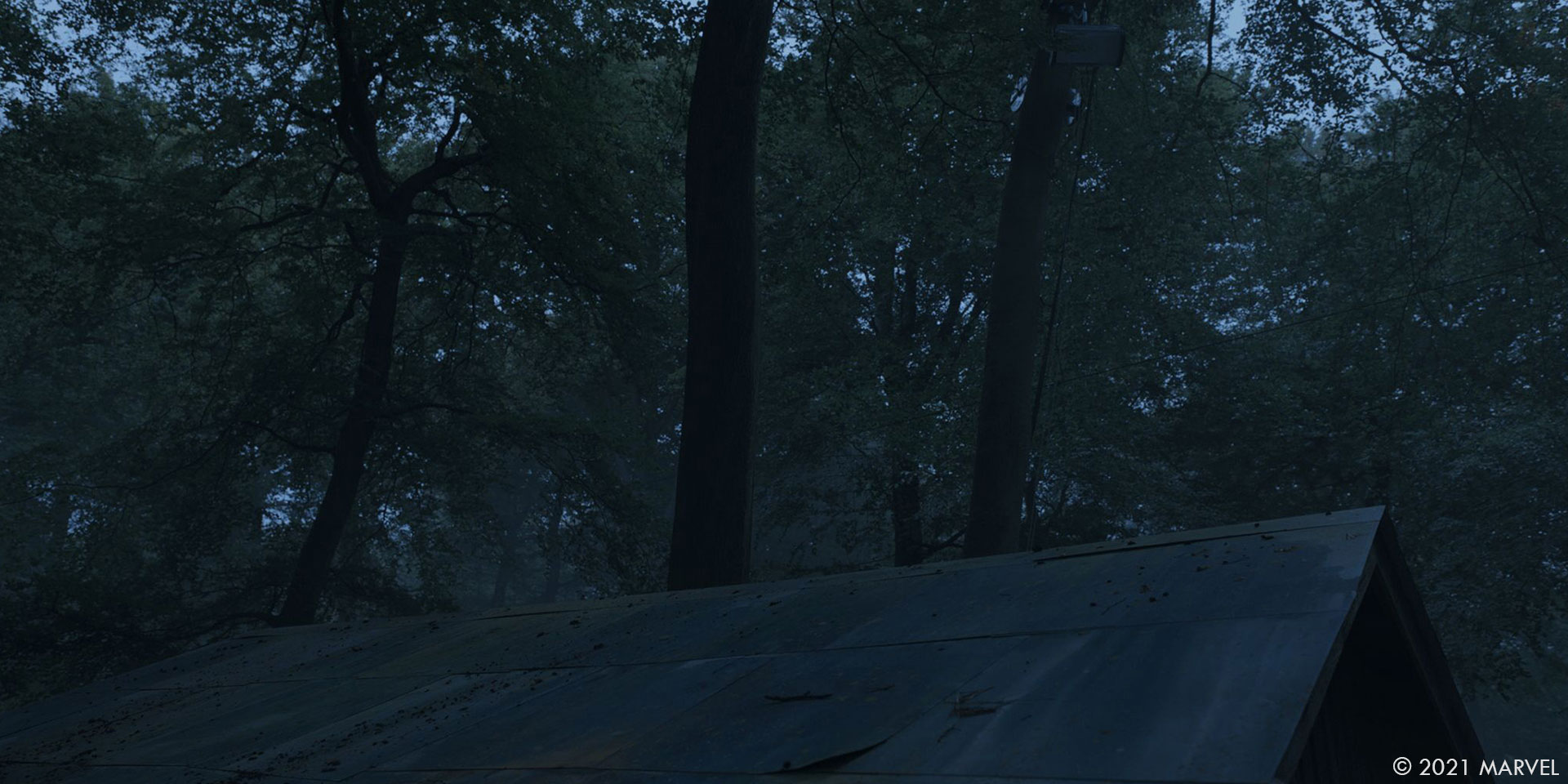
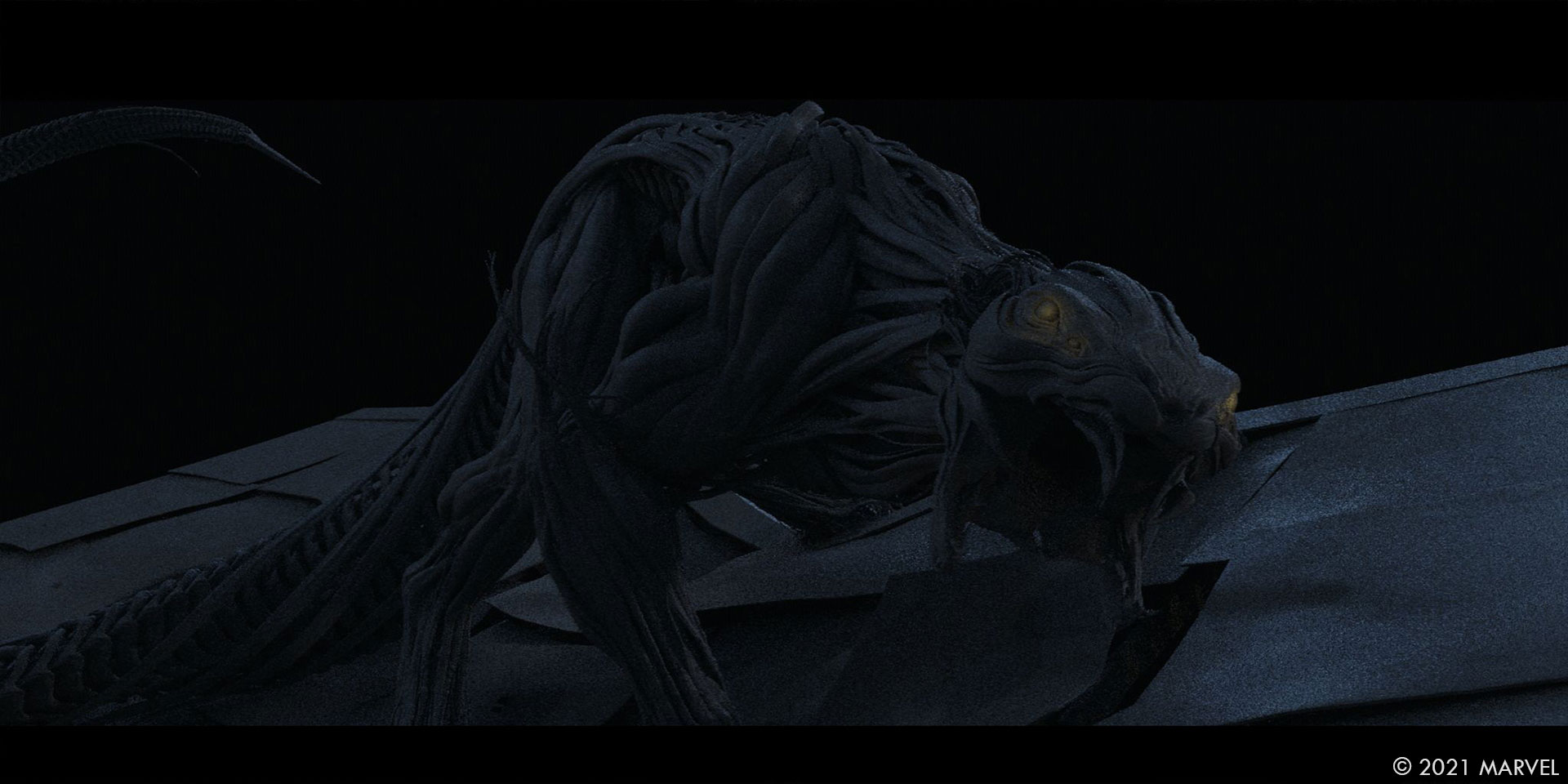
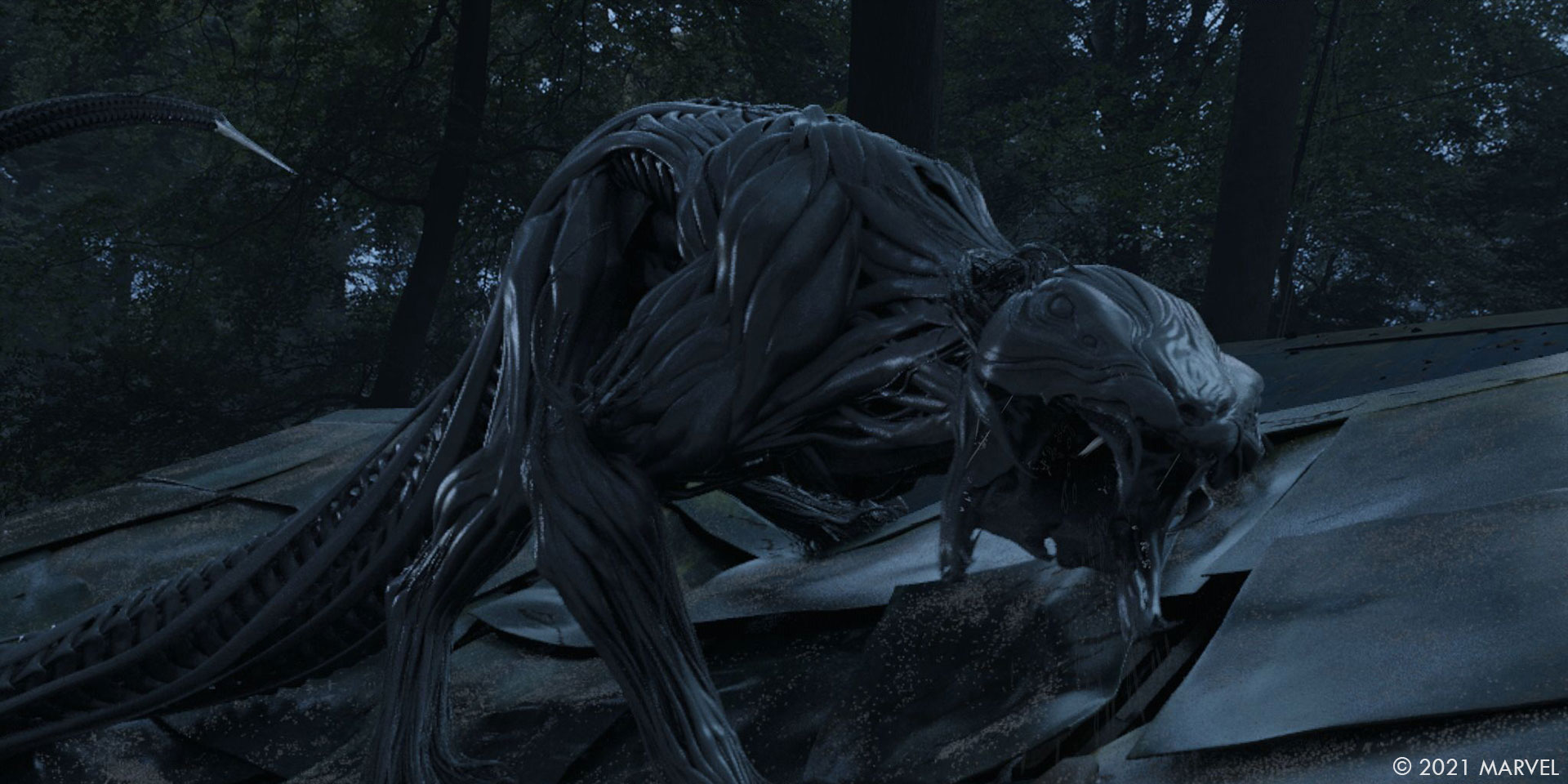
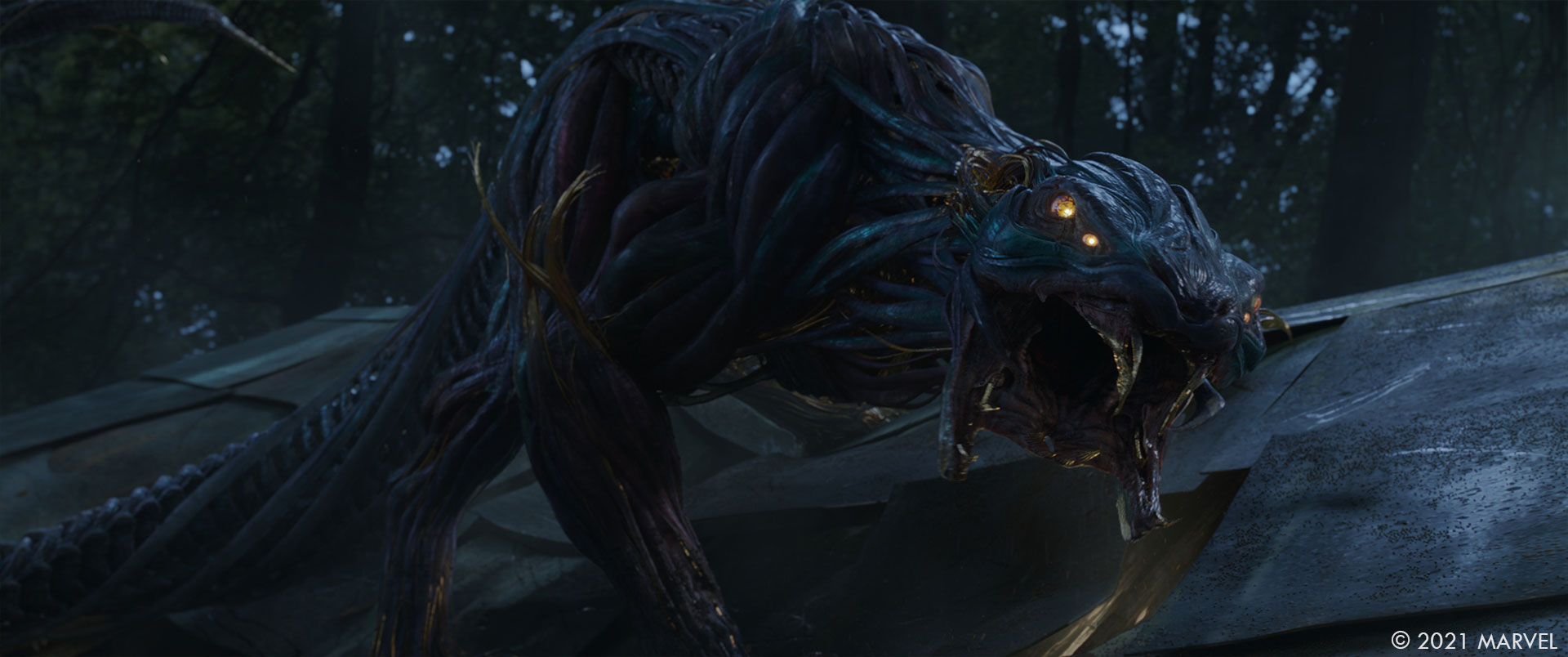
What is your favorite shot or sequence?
Daniele Bigi // The Druig Compound Battle is my favorite sequence.
What is your best memory on this show?
Daniele Bigi // Taking photographic references inside the Mesopotamian department at the London British Museum for many hours at night. We couldn’t go during the opening hours. Being inside such a beautiful museum almost alone has been a magical and surreal experience.
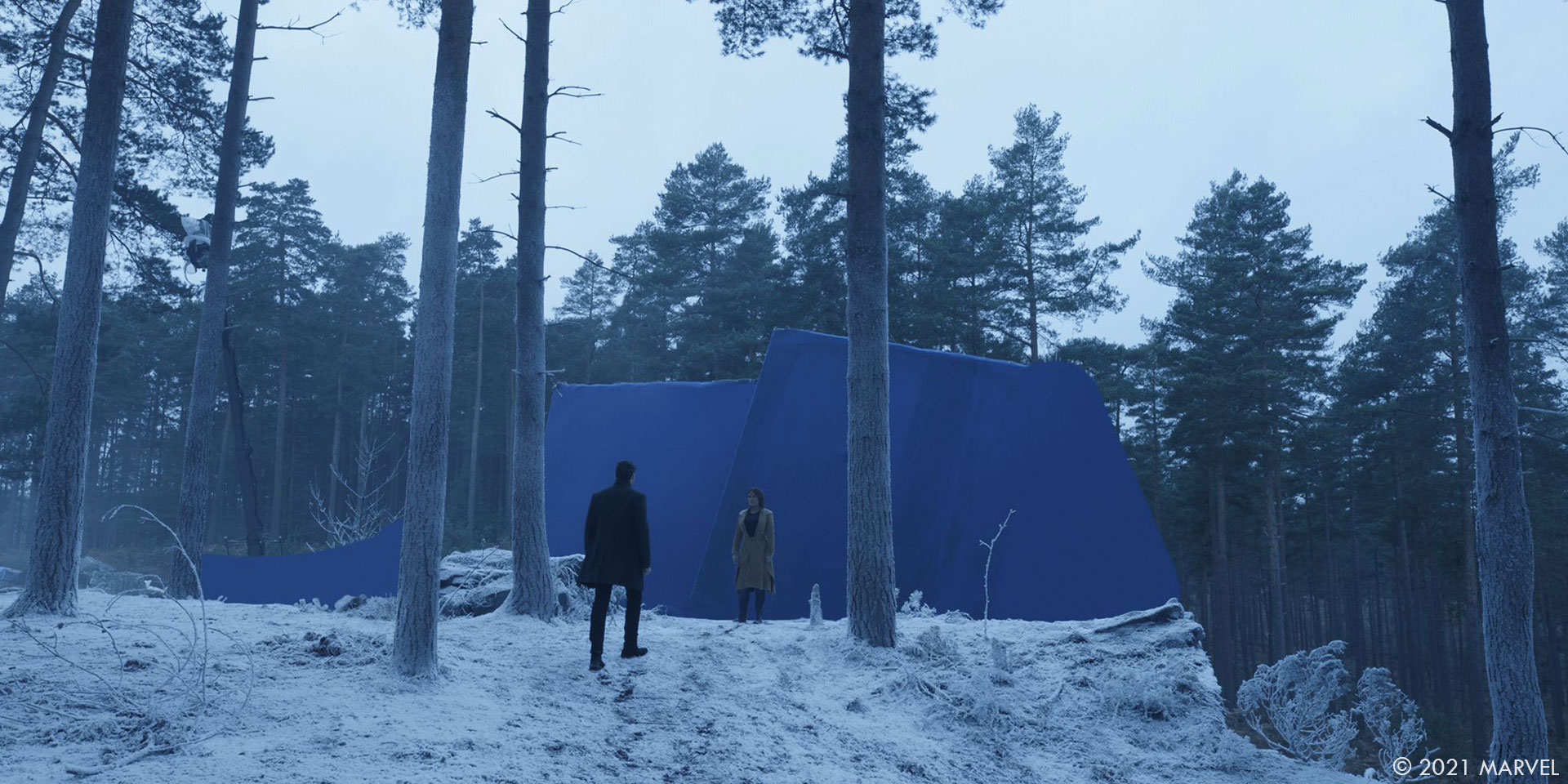
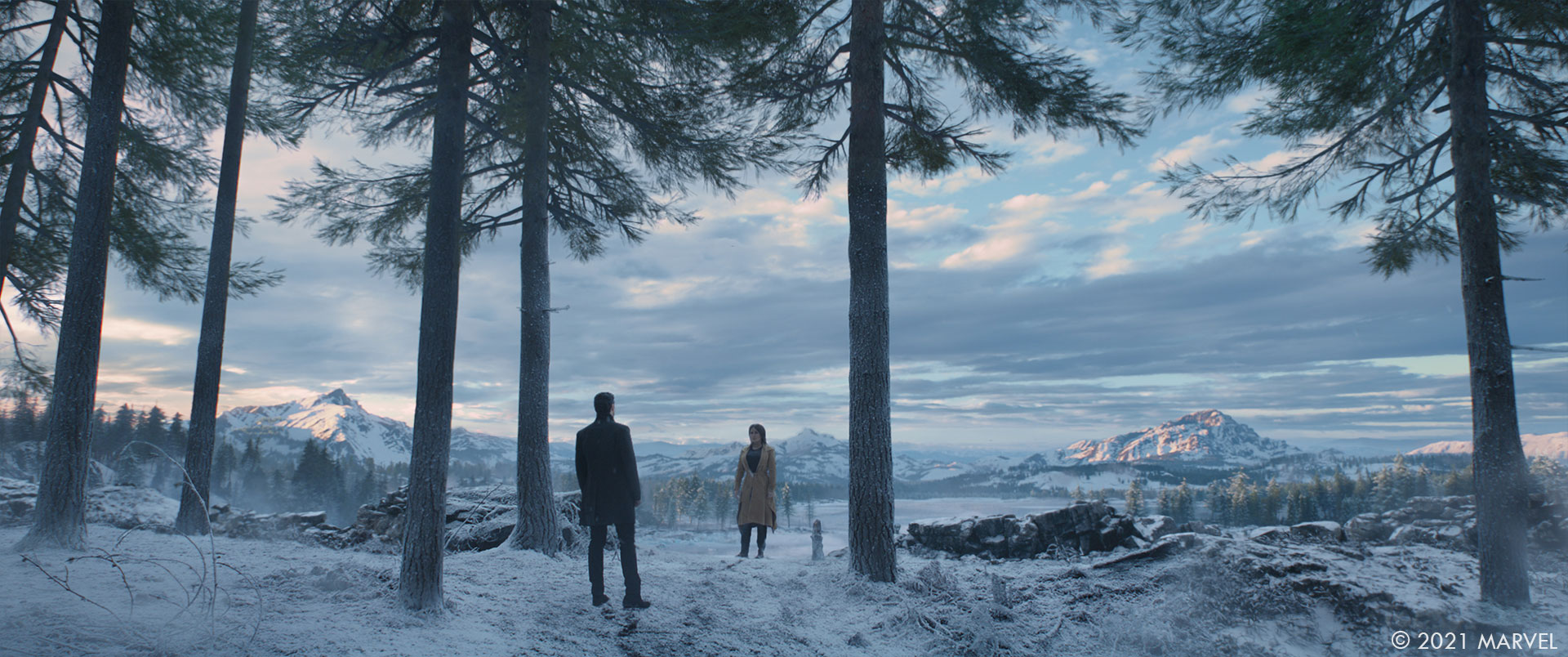
How long have you worked on this show?
Daniele Bigi // I worked on Eternals for around 22 months.
What’s the VFX shots count?
Claudia Lecaros // ILM completed 329 VFX shots overall, including some of the lengthier DCB shots which had multiple plate stitches.
What was the size of your team?
Claudia Lecaros // Over the course of the project our Global Team size was about 420 people across our global studios in London, Vancouver, Singapore, San Francisco, and Sydney.
What is your next project?
Daniele Bigi // I’m taking a long time off to recharge my batteries and spend quality time with my family. I’m not sure what I’m going to do next just yet.
A big thanks for your time.
// Eternals – VFX Breakdown by ILM
WANT TO KNOW MORE?
ILM: Dedicated page about Eternals on ILM website.
Stephane Ceretti: Here is my interview of Stephane Ceretti, Overall VFX Supervisor on Eternals.
Disney+: You can now watch Eternals on Disney+.
© Vincent Frei – The Art of VFX – 2022




